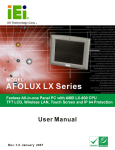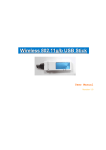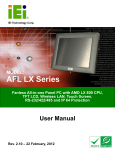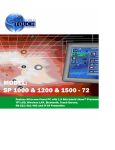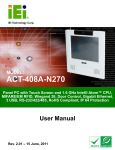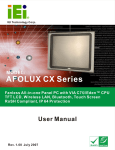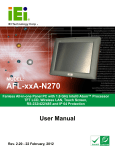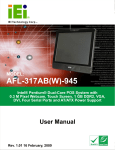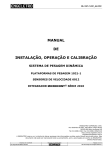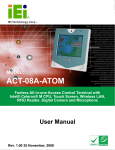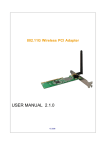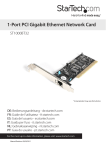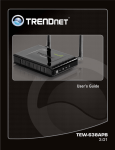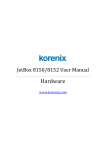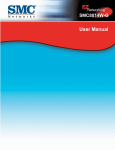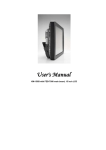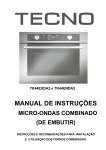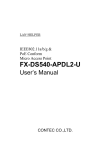Download ACT-08A-CX2 All-in-One Access Control Terminal User Manual
Transcript
ACT-08-CX2 Access Control Terminal ACT-08A-CX2 Access Control Terminal Page i ACT-08A-CX2 Access Control Terminal Revision Date Version Changes 2008-09 1.01 Modified COM 1 and COM 2 locations Modified the preinstalled SO-DIMM SDRAM to 512 MB Added RS-422 and RS-485 pinouts 2008-08 Page ii 1.00 Initial release ACT-08-CX2 Access Control Terminal Copyright COPYRIGHT NOTICE The information in this document is subject to change without prior notice in order to improve reliability, design and function and does not represent a commitment on the part of the manufacturer. In no event will the manufacturer be liable for direct, indirect, special, incidental, or consequential damages arising out of the use or inability to use the product or documentation, even if advised of the possibility of such damages. This document contains proprietary information protected by copyright. All rights are reserved. No part of this manual may be reproduced by any mechanical, electronic, or other means in any form without prior written permission of the manufacturer. TRADEMARKS All registered trademarks and product names mentioned herein are used for identification purposes only and may be trademarks and/or registered trademarks of their respective owners. Page iii ACT-08A-CX2 Access Control Terminal Manual Conventions WARNING! Warnings appear where overlooked details may cause damage to the equipment or result in personal injury. Warnings should be taken seriously. Warnings are easy to recognize. The word “warning” is written as “WARNING,” both capitalized and bold and is followed by text. The text is the warning message. A warning message is shown below: WARNING: This is an example of a warning message. Failure to adhere to warning messages may result in permanent damage to the ACT-08A-CX2 or personal injury to the user. Please take warning messages seriously. CAUTION! Cautionary messages should also be heeded to help reduce the chance of losing data or damaging the ACT-08A-CX2. Cautions are easy to recognize. The word “caution” is written as “CAUTION,” both capitalized and bold and is followed. The italicized text is the cautionary message. A caution message is shown below: Page iv ACT-08-CX2 Access Control Terminal CAUTION: This is an example of a caution message. Failure to adhere to cautions messages may result in permanent damage to the ACT-08A-CX2. Please take caution messages seriously. NOTE: These messages inform the reader of essential but non-critical information. These messages should be read carefully as any directions or instructions contained therein can help avoid making mistakes. Notes are easy to recognize. The word “note” is written as “NOTE,” both capitalized and bold and is followed by text. The text is the cautionary message. A note message is shown below: NOTE: This is an example of a note message. Notes should always be read. Notes contain critical information about the ACT-08A-CX2. Please take note messages seriously. Page v ACT-08A-CX2 Access Control Terminal Packing List NOTE: If any of the components listed in the checklist below are missing, please do not proceed with the installation. Contact the IEI reseller or vendor you purchased the ACT-08A-CX2 from or contact an IEI sales representative directly. To contact an IEI sales representative, please send an email to [email protected]. The items listed below should all be included in the ACT-08A-CX2 series package. 1 x ACT-08A-CX2 system 1 x Screw set 1 x Power adapter 1 x eSATA cable 1 x Touch pen 1 x User Manual and driver CD Images of the above items are shown in Chapter 3 on page 21. Page vi ACT-08-CX2 Access Control Terminal Table of Contents 1 INTRODUCTION..................................................................................................... 1 1.1 ACT-08A-CX2 ALL-IN-ONE ACCESS CONTROL TERMINAL ...................................... 2 1.1.1 Features and Model Variations.......................................................................... 3 1.1.2 Applications ....................................................................................................... 3 1.2 EXTERNAL OVERVIEW ............................................................................................... 3 1.2.1 General Description........................................................................................... 3 1.2.2 Front Panel ........................................................................................................ 4 1.2.3 Rear Panel ......................................................................................................... 4 1.2.4 Bottom Panel...................................................................................................... 5 1.2.5 Side Panels......................................................................................................... 6 1.3 INTERNAL OVERVIEW................................................................................................. 6 1.4 SPECIFICATIONS ......................................................................................................... 7 1.4.1 Preinstalled Hardware Components .................................................................. 7 1.4.2 System Specifications ......................................................................................... 7 2 DETAILED SPECIFICATIONS ........................................................................... 10 2.1 DIMENSIONS .............................................................................................................11 2.1.1 ACT-08A-CX2 Dimensions ...............................................................................11 2.2 PROCESSOR SUPPORT ............................................................................................... 12 2.3 MOTHERBOARD COMPONENTS................................................................................. 12 2.3.1 Memory Support............................................................................................... 12 2.3.1.1 Installed Memory ...................................................................................... 12 2.3.1.2 Maximum Memory ................................................................................... 12 2.3.2 Storage Capacity.............................................................................................. 13 2.4 ACT-08A-CX2 FRONT SIDE .................................................................................... 13 2.4.1 Monitor ............................................................................................................ 13 2.4.2 Touch-Screen Module....................................................................................... 14 2.4.3 RFID Reader.................................................................................................... 14 2.4.4 Digital Camera and Microphone ..................................................................... 14 2.4.5 Stereo Speakers ................................................................................................ 15 2.5 EXTERNAL PERIPHERAL INTERFACE CONNECTORS .................................................. 15 Page vii ACT-08A-CX2 Access Control Terminal 2.5.1 Serial Port Connectors .................................................................................... 15 2.5.2 LAN Connectivity ............................................................................................. 15 2.5.3 External USB Connectors ................................................................................ 16 2.5.4 External SATA Connector ................................................................................ 17 2.6 SYSTEM POWER ....................................................................................................... 17 2.6.1 Power Adapter ................................................................................................. 17 2.6.2 Power Connectors............................................................................................ 17 2.7 WIRELESS CONNECTION .......................................................................................... 18 2.7.1 Wireless Ethernet ............................................................................................. 18 3 UNPACKING .......................................................................................................... 19 3.1 UNPACKING.............................................................................................................. 20 3.1.1 Packing List ..................................................................................................... 21 4 INSTALLATION .................................................................................................... 22 4.1 ANTI-STATIC PRECAUTIONS ...................................................................................... 23 4.2 INSTALLATION PRECAUTIONS ................................................................................... 23 4.3 PREINSTALLED COMPONENTS .................................................................................. 24 4.4 INSTALLATION AND CONFIGURATION STEPS ............................................................. 24 4.5 REAR PANEL REMOVAL ............................................................................................ 25 4.6 CF CARD INSTALLATION .......................................................................................... 25 4.7 JUMPER SETTINGS .................................................................................................... 27 4.7.1 Access the Jumpers .......................................................................................... 27 4.7.2 Preconfigured Jumpers .................................................................................... 29 4.7.3 COM1 and COM2 Pin 9 Select........................................................................ 29 4.7.4 COM 2 Function Select Jumper....................................................................... 30 4.7.4.1 RS-422 and RS-485 Pinouts ..................................................................... 32 4.7.5 AT/ATX Mode Selection ................................................................................... 33 4.8 MOUNTING THE SYSTEM .......................................................................................... 33 4.8.1 Wall Mounting (Optional) ................................................................................ 33 4.8.2 Panel Mounting................................................................................................ 36 4.8.3 Arm Mounting .................................................................................................. 38 4.8.4 Cabinet and Rack Installation ......................................................................... 39 4.9 BOTTOM PANEL CONNECTORS ................................................................................. 41 4.9.1 LAN Connection............................................................................................... 41 Page viii ACT-08-CX2 Access Control Terminal 4.9.2 Serial Device Connection ................................................................................ 42 4.9.3 USB Device Connection................................................................................... 43 5 RFID READER....................................................................................................... 45 5.1 INTRODUCTION ........................................................................................................ 46 5.2 INSTALLATION .......................................................................................................... 46 5.3 RF320 INTERFACE OVERVIEW ................................................................................. 49 5.4 SERIAL PORT (COM) SETTINGS ............................................................................... 50 5.5 RF320 COMMANDS ................................................................................................. 51 5.5.1 Read Block ....................................................................................................... 51 5.5.2 Write Block....................................................................................................... 53 5.5.3 Set Mifare Parameter....................................................................................... 54 5.5.4 Get Mifare Parameter ...................................................................................... 56 5.5.5 Set RF320 Mode............................................................................................... 57 6 SYSTEM MAINTENANCE .................................................................................. 59 6.1 SYSTEM MAINTENANCE INTRODUCTION .................................................................. 60 6.2 ANTI-STATIC PRECAUTIONS ...................................................................................... 60 6.3 TURN OFF THE POWER .............................................................................................. 61 6.4 REMOVING THE REAR PANEL ................................................................................... 61 6.5 REPLACING COMPONENTS ....................................................................................... 63 6.5.1 CF Card Replacement...................................................................................... 63 6.5.2 SO-DIMM Module Replacement...................................................................... 63 6.5.3 Wireless Module Replacement ......................................................................... 65 6.5.4 Motherboard Replacement............................................................................... 66 7 AMI BIOS SETUP.................................................................................................. 67 7.1 INTRODUCTION ........................................................................................................ 68 7.1.1 Starting Setup................................................................................................... 68 7.1.2 Using Setup ...................................................................................................... 68 7.1.3 Getting Help..................................................................................................... 69 7.1.4 Unable to Reboot After Configuration Changes.............................................. 69 7.1.5 BIOS Menu Bar................................................................................................ 69 7.2 MAIN ....................................................................................................................... 70 7.3 ADVANCED ............................................................................................................... 71 7.3.1 CPU Configuration.......................................................................................... 72 Page ix ACT-08A-CX2 Access Control Terminal 7.3.2 IDE Configuration ........................................................................................... 73 7.3.2.1 IDE Master, IDE Slave ............................................................................. 75 7.3.3 Super IO Configuration.................................................................................... 80 7.3.4 Remote Access Configuration .......................................................................... 82 7.3.5 USB Configuration........................................................................................... 85 7.3.6 Power Configuration ....................................................................................... 87 7.3.7 ACPI Configuration ......................................................................................... 88 7.3.8 APM Configuration.......................................................................................... 89 7.4 PCI/PNP .................................................................................................................. 92 7.5 BOOT ....................................................................................................................... 94 7.5.1 Boot Settings Configuration............................................................................. 95 7.6 SECURITY................................................................................................................. 98 7.7 CHIPSET ................................................................................................................... 99 7.7.1 NorthBridge VIA CX700 Configuration ........................................................ 100 7.7.2 SouthBridge VIA CX700 Configuration......................................................... 102 7.8 EXIT ....................................................................................................................... 104 A SYSTEM SPECIFICATIONS ............................................................................. 106 7.9 MOTHERBOARD SPECIFICATIONS ........................................................................... 107 A.1 SCREEN SPECIFICATIONS ....................................................................................... 107 A.2 TOUCH SCREEN SPECIFICATIONS ........................................................................... 108 A.3 WIRELESS MODULE .............................................................................................. 109 A.4 VGA WEBCAM ......................................................................................................110 A.5 POWER ADAPTER ...................................................................................................111 B SAFETY PRECAUTIONS....................................................................................112 B.1 SAFETY PRECAUTIONS............................................................................................113 B.1.1 General Safety Precautions ............................................................................113 B.1.2 Anti-static Precautions ...................................................................................114 B.2 MAINTENANCE AND CLEANING PRECAUTIONS .......................................................114 B.2.1 Maintenance and Cleaning.............................................................................114 B.2.2 Cleaning Tools ................................................................................................115 C BIOS CONFIGURATION OPTIONS .................................................................116 C.1 BIOS CONFIGURATION OPTIONS ............................................................................117 Page x ACT-08-CX2 Access Control Terminal D WATCHDOG TIMER .......................................................................................... 120 E HAZARDOUS MATERIALS DISCLOSURE ................................................... 123 E.1 HAZARDOUS MATERIAL DISCLOSURE TABLE FOR IPB PRODUCTS CERTIFIED AS ROHS COMPLIANT UNDER 2002/95/EC WITHOUT MERCURY ..................................... 124 F INDEX.................................................................................................................... 127 Page xi ACT-08A-CX2 Access Control Terminal List of Figures Figure 1-1: ACT-08A-CX2 All-in-One Access Control Terminal ...............................2 Figure 1-2: ACT-08A-CX2 Front View ..........................................................................4 Figure 1-3: ACT-08A-CX2 Rear View ...........................................................................5 Figure 1-4: ACT-08A-CX2 Bottom View.......................................................................6 Figure 1-5: ACT-08A-CX2 Side View............................................................................6 Figure 2-1: ACT-08A-CX2 Dimensions (mm) ............................................................11 Figure 2-2: Memory Module and Memory Socket ....................................................13 Figure 2-3: CompactFlash® Slot................................................................................13 Figure 2-4: SVGA Screen............................................................................................14 Figure 2-5: COM Ports ................................................................................................15 Figure 2-6: RJ-45 Ethernet Connector ......................................................................16 Figure 2-7: External USB Ports..................................................................................17 Figure 2-8: External SATA Connector.......................................................................17 Figure 2-9: Power Connector and Power Switch .....................................................18 Figure 2-10: Wireless LAN Mini PCI Card .................................................................18 Figure 4-1: Rear Panel Retention Screws.................................................................25 Figure 4-2: CF Socket Location .................................................................................26 Figure 4-3: CF Card Installation.................................................................................26 Figure 4-4: Jumper Locations....................................................................................27 Figure 4-5: Rear Panel Retention Screws.................................................................28 Figure 4-6: Aluminum Chassis Cover Retention Screws........................................28 Figure 4-7: COM1 and COM2 Pin 9 Setting Jumper Locations ..............................30 Figure 4-8: COM 2 Function Select Jumper Locations ...........................................32 Figure 4-9: AT/ATX Switch .........................................................................................33 Figure 4-10: Wall-mounting Bracket..........................................................................34 Figure 4-11: Chassis Support Screws.......................................................................35 Figure 4-12: Secure the ACT-08A-CX2 ......................................................................36 Figure 4-13: ACT-08A-CX2 Panel Opening (mm) .....................................................37 Page xii ACT-08-CX2 Access Control Terminal Figure 4-14: Tighten the Panel Mounting Clamp Screws........................................37 Figure 4-15: ACT-08A-CX2 Arm Mounting Retention Screw Holes........................39 Figure 4-16: The Rack/Cabinet Bracket ....................................................................40 Figure 4-17: Secure the Rack/Cabinet Bracket ........................................................40 Figure 4-18: Install into a Rack/Cabinet ....................................................................41 Figure 4-19: LAN Connection.....................................................................................42 Figure 4-20: Serial Device Connector .......................................................................43 Figure 4-21: USB Device Connection........................................................................44 Figure 5-1: InstallShield Wizard Welcome Screen...................................................46 Figure 5-2: Customer Information Screen ................................................................47 Figure 5-3: Setup Type Selection Screen .................................................................47 Figure 5-4: Current Settings Confirmation Screen ..................................................48 Figure 5-5: RF320 COM Port Settings .......................................................................50 Figure 5-6: Read Block ...............................................................................................52 Figure 5-7: Write Block ...............................................................................................53 Figure 5-8: Set Mifare Parameter ...............................................................................55 Figure 5-9: Get Mifare Parameter...............................................................................56 Figure 5-10: Set RF-320 Mode....................................................................................58 Figure 6-1: Rear Panel Retention Screws.................................................................62 Figure 6-2: Aluminum Chassis Cover Retention Screws........................................62 Figure 6-3: SO-DIMM Socket Location ......................................................................64 Figure 6-4: SO-DIMM Installation...............................................................................64 Figure 6-5: Wireless Module Location ......................................................................65 Figure 6-6: Installing a Wireless Module...................................................................66 Page xiii ACT-08A-CX2 Access Control Terminal List of Tables Table 1-1: ACT-08A-CX2 System Specifications........................................................9 Table 4-1: Jumpers......................................................................................................27 Table 4-2: Preconfigured Jumpers ............................................................................29 Table 4-3: COM1 and COM2 Pin 9 Setting Jumper Settings ...................................30 Table 4-4: COM 2 Function Select Jumper Settings (JP7)......................................31 Table 4-5: COM 2 Function Select Jumper Settings (JP15)....................................31 Table 4-6: COM 2 Function Select Jumper Settings (JP17)....................................31 Table 4-7: RS-422 Pinouts ..........................................................................................32 Table 4-8: RS-485 Pinouts ..........................................................................................32 Table 5-1: RF320 COM Port Settings.........................................................................50 Table 5-2: Read Block Raw Data Format ..................................................................52 Table 5-3: Read Block Response Format .................................................................52 Table 5-4: Write Block Raw Data Format ..................................................................54 Table 5-5: Write Block Response Format .................................................................54 Table 5-6: Set Mifare Parameter Raw Data Format ..................................................55 Table 5-7: Set Mifare Parameter Response Format .................................................55 Table 5-8: Get Mifare Parameter Raw Data Format..................................................56 Table 5-9: Get Mifare Parameter Response Format.................................................57 Table 5-10: Set RF320 Mode Raw Data Format ........................................................58 Table 5-11: Set RF320 Mode Response Format .......................................................58 Table 7-1: BIOS Navigation Keys...............................................................................69 Page xiv ACT-08-CX2 Access Control Terminal Chapter 1 1 Introduction Page 1 ACT-08A-CX2 Access Control Terminal 1.1 ACT-08A-CX2 All-in-One Access Control Terminal Figure 1-1: ACT-08A-CX2 All-in-One Access Control Terminal The ACT-08A-CX2 is VIA Eden™ 1 GHz ULV powered access control terminal with a RFID reader and a rich variety of functions. The ACT-08A-CX2 is designed for easy and simplified integration in to access control applications. A VIA CX700M chipset ensures optimal memory, graphics, and peripheral I/O support. The system comes with 512 MB of preinstalled DDR2 SDRAM and supports a maximum of 1.0 GB of DDR2 SDRAM ensuring smooth data throughputs with reduced bottlenecks and fast system access. Two serial ports and four external USB 2.0 ports ensure simplified connectivity to a variety of external peripheral devices. Wi-Fi capabilities and an RJ-45 Ethernet connector ensure smooth connection of the system to an external LAN. Page 2 ACT-08-CX2 Access Control Terminal 1.1.1 Features and Model Variations The ACT-08A-CX2 features the following: 8.4” TFT LCD with resistive type touch screen VIA Eden™ 1 GHz ULV CPU preinstalled Built-in RFID reader supports Mifare card and EM card read/write Preinstalled 512 MB DDR2 memory module 802.11 b/g wireless module One RS-232 port and one RS-232/422/485 port Four standard USB 2.0 ports CompactFlash® Type II slot Provides RFID configuration tool to read or write Mifare tags and EM tags Built-in digital camera and microphone Built-in two 2.0 W stereo speakers IP 64 compliant front panel Second displays support RoHS compliance 1.1.2 Applications The ACT-08A-CX2 is elegant yet sophisticated systems that are easily implemented in diverse environments including: Door access Time attendance Cashless payment terminal Parking access control 1.2 External Overview 1.2.1 General Description The stylish ACT-08A-CX2 access control terminal comprises of a screen, rear panel, top panel, bottom panel and two side panels (left and right). An ABS/PC plastic front frame surrounds the front screen. The rear panel provides screw holes for a wall-mounting bracket compliant with VESA FDMI standard. An I/O interface panel on the rear panel of Page 3 ACT-08A-CX2 Access Control Terminal the ACT-08A-CX2 provides access to external interface connectors that include LAN, USB 2.0, serial port, reset button, power connector and power switch. 1.2.2 Front Panel The front side of the ACT-08A-CX2 is a flat panel TFT LCD screen surrounded by an ABS/PC plastic hard cover . The top of the front panel has one 300 K pixel digital camera , two microphones and one power LED indicator. The bottom of the front panel features a RFID reader for Mifare/EM tag and two speakers for stereo sound (Figure 1-2). Figure 1-2: ACT-08A-CX2 Front View 1.2.3 Rear Panel The rear panel provides access to retention screw holes that support the VESA MIS-D 75 mounting. Refer to Figure 1-3. Page 4 ACT-08-CX2 Access Control Terminal Figure 1-3: ACT-08A-CX2 Rear View 1.2.4 Bottom Panel The I/O interface panel located on the bottom panel of the ACT-08A-CX2 (Figure 1-4) has the following I/O interface connectors: 1 x 12 V DC power jack 1 x Power switch 1 x External SATA connector 1 x RS-232 port 1 x RS-232 or RS-422/485 port 1 x GbE connector 4 x USB 2.0 ports 1 x Reset button The external I/O interface connectors on the rear panel are shown in Figure 1-4. Page 5 ACT-08A-CX2 Access Control Terminal Figure 1-4: ACT-08A-CX2 Bottom View 1.2.5 Side Panels The two side panels of the ACT-08A-CX2 provides access to slots that support panel mount and rack mount. See Figure 1-5. Figure 1-5: ACT-08A-CX2 Side View 1.3 Internal Overview The ACT-08A-CX2 has the following components installed internally: 1 x Motherboard 1 x 512 MB DDR2 SDRAM SO-DIMM 1 x Wireless module 1 x RFID reader Page 6 ACT-08-CX2 Access Control Terminal 2 x Speakers 1 x Digital camera 2 x Microphones 1.4 Specifications 1.4.1 Preinstalled Hardware Components The ACT-08A-CX2 has the following preinstalled components: 1 x Motherboard 1 x TFT LCD screen 1 x Touch screen 1 x Inverter 1 x Wireless LAN module 1 x DDR2 memory module 1 x AT/ATX switch The following section lists the system specifications. The technical specifications for some other preinstalled components are shown in the Appendix A. 1.4.2 System Specifications The technical specifications for the ACT-08A-CX2 system are listed in Table 1-1. Specification ACT-08A-CX2 LCD Size 8.4” Max. Resolution 800 x 600 (XGA) Brightness 400 cd/m2 Contrast Ratio 500:1 LCD Color 262 K Pixel Pitch (mm) 0.213 (H) x 0.213 (V) Page 7 ACT-08A-CX2 Access Control Terminal Viewing Angle (H-V) 120 (H) / 100 (V) Backlight MTBF 50,000 hours SBC Model AFLMB-CX2 CPU 1 GHz VIA Eden™ ULV GMCH VIA CX700M Memory One 512 MB DDR2 SDRAM SO-DIMM pre-installed (system max. 1 GB) SSD CF Type II Watchdog Timer Software Programmable supports 1 sec. ~ 255 sec. system reset Audio AMP 2.0 W + AMP 2.0 W (built-in stereo speakers) Expansion 1 x Mini PCI slot (for wireless LAN 802.11 b/g module) Bluetooth Supports Bluetooth connectivity Camera and MIC Built-in 300 K pixel camera and digital microphone RFID Supports MIFARE and EM RFID Construction Material ABS + PC plastic front frame Aluminum alloy chassis Front Panel Color Blue and White Mounting Panel, Wall, Stand or Arm (VESA MIS-D 75) Dimensions (W x H x D) (mm) 244.69 x 251.72 x 53.3 Operation Temperature 0ºC ~ 45ºC Net weight 1.1 kg IP level (front panel) IP 64 EMC CE, EMC and FCC Page 8 ACT-08-CX2 Access Control Terminal Safety CB and CCC Touch Screen 4-wire resistive type Power Adapter 48 W Power Consumption 38 W I/O Ports and Switches 1 x 12 V DC power jack (Rear Panel) 1 x Power switch 1 x External SATA connector 1 x RS-232 port 1 x RS-232 or RS-422/485 port 1 x GbE connector 4 x USB 2.0 1 x Reset button Table 1-1: ACT-08A-CX2 System Specifications Page 9 ACT-08A-CX2 Access Control Terminal Chapter 2 2 Detailed Specifications Page 10 ACT-08-CX2 Access Control Terminal 2.1 Dimensions The following sections provide detailed schematics and information on the dimensions of the ACT-08A-CX2. 2.1.1 ACT-08A-CX2 Dimensions The dimensions of the ACT-08A-CX2 are shown in Figure 2-1 and listed below. Width: 244.69 mm Height: 251.72 mm Depth: 53.3 mm Figure 2-1: ACT-08A-CX2 Dimensions (mm) Page 11 ACT-08A-CX2 Access Control Terminal 2.2 Processor Support A VIA Eden™ ULV processor is installed in the system. The processor has a CPU speed of 1.0 GHz and a 400 MHz FSB. VIA Eden™ ULV processor supports the following VIA features: 90 nanometer process technology VIA CoolStream™ architecture minimizes power consumption VIA StepAhead™ technology VIA PadLock™ security engine 2.3 Motherboard Components The following sections describe some of the features on the motherboard. 2.3.1 Memory Support 2.3.1.1 Installed Memory One 512 MB DDR2 SDRAM SO-DIMM is installed in the ACT-08A-CX2 and controlled by the Northbridge installed on the internal motherboard. 2.3.1.2 Maximum Memory The VIA CX700M is capable of supporting one 200-pin 1.0 GB (system max.) DDR2 SDRAM SO-DIMM. If different memory is required, please contact an IEI sales representative and discuss the necessary system requirement. Page 12 ACT-08-CX2 Access Control Terminal Figure 2-2: Memory Module and Memory Socket 2.3.2 Storage Capacity The system can also support a CompactFlash® Type II (CF Type II) memory disk (Figure 2-3). Figure 2-3: CompactFlash® Slot 2.4 ACT-08A-CX2 Front Side 2.4.1 Monitor An 8.4” SVGA LCD screen is installed on the front of the ACT-08A-CX2. The installed monitor has a pixel resolution of 800 x 600 pixels with 400 nits high brightness. The screen is shown in Figure 2-4 below. Page 13 ACT-08A-CX2 Access Control Terminal Figure 2-4: SVGA Screen 2.4.2 Touch-Screen Module A controller for the 4-wire resistive touch screen is connected to the motherboard through the RS-232 interface. The sensitive touch screen is accurate, reliable and durable. 2.4.3 RFID Reader A RFID reader is integrated in the front panel and supports Mifare 13.56 MHz or EM 125 KHz RFID tags. The ACT-08A-CX2 also came with a RFID tool to read or write data on or into the Mifare tags or EM tags. Please refer to Chapter 5 for detailed description of the RFID tool (RF320). 2.4.4 Digital Camera and Microphone The ACT-08A-CX2 is built in with a 300 K digital camera and a set of microphone on the front panel (Figure 2-4). The user can use the camera and microphone for facial and voice recognition for access control applications. Page 14 ACT-08-CX2 Access Control Terminal 2.4.5 Stereo Speakers Two 2.0 W stereo speakers on the front side of the ACT-08A-CX2 are interfaced to the system through a class-B dual output amplifier (Figure 2-4). 2.5 External Peripheral Interface Connectors The following section describes the external peripheral interface connectors on the bottom panel of the ACT-08A-CX2. 2.5.1 Serial Port Connectors The ACT-08A-CX2 has two serial ports on the bottom panel. One of these ports (COM 1) is RS-232 only port and the other serial port (COM 2) can be configured as a RS-232, RS-422 or an RS-485 serial port. Figure 2-5: COM Ports 2.5.2 LAN Connectivity The ACT-08A-CX2 supports GbE connectivity through the RJ-45 connector on the bottom panel. Page 15 ACT-08A-CX2 Access Control Terminal Figure 2-6: RJ-45 Ethernet Connector The PCI lane from the VIA CX700M chipset of the ACT-08A-CX2 is interfaced to a Realtek RTL8110SC PCI gigabit Ethernet (GbE) controller. The RTL8110SC is then connected directly to the RJ-45 connector on the bottom panel and provides external GbE connectivity. Some of the RTL8110SC controller features are listed below: Integrated 10/100/1000 transceiver Supports PCI rev.2.3, 32-bit, 33/66MHz Fully compliant with IEEE 802.3, IEEE 802.3u, IEEE 802.3ab Supports IEEE 802.1P Layer 2 Priority Encoding Supports IEEE 802.1Q VLAN tagging Serial EEPROM 3.3/1.8/1.5V signaling, 5V PCI I/O tolerant 0.15µm CMOS process Transmit/Receive FIFO (8K/64K) support Supports PCI Message Signaled Interrupt (MSI) 2.5.3 External USB Connectors The ACT-08A-CX2 has four USB 2.0 connectors. All of the USB 2.0 connectors are interfaced directly to the USB controllers on the VIA CX700M. The USB connectors are fully compliant with USB specification Revision 2.0 and USB specification Revision 1.1 and can be interfaced to both USB 1.1 and USB 2.0 compliant devices. Page 16 ACT-08-CX2 Access Control Terminal Figure 2-7: External USB Ports 2.5.4 External SATA Connector An external SATA connector on the bottom panel interfaces to VIA CX700M chipset on the motherboard that connects through the serial ATA bus. The external SATA connector supports one external SATA drive. Figure 2-8: External SATA Connector 2.6 System Power 2.6.1 Power Adapter The system is shipped with a 90 V to 264 V IEI AC power adapter that has a maximum power output of 48 W. The power supply is shown in below. 2.6.2 Power Connectors A standard power jack on the bottom panel of the ACT-08A-CX2 is connected to the power adapter and can input 12 V of direct current (DC) into the system. The power connector and power switch are shown in Figure 2-9 below. Page 17 ACT-08A-CX2 Access Control Terminal Figure 2-9: Power Connector and Power Switch 2.7 Wireless Connection The following section describes the wireless modules on the circuit. 2.7.1 Wireless Ethernet An integrated 802.11 b/g wireless LAN module and PIFA antenna on the ACT-08A-CX2 ensure an uninterrupted wireless connection. PIFA antennas can receive high-quality, uniform signals in any location from all directions without any signal degradation or impedance and are the most efficient antennas on the market. Figure 2-10: Wireless LAN Mini PCI Card Page 18 ACT-08-CX2 Access Control Terminal Chapter 3 3 Unpacking Page 19 ACT-08A-CX2 Access Control Terminal 3.1 Unpacking To unpack the access control terminal, follow the steps below: WARNING! The front side LCD screen has a protective plastic cover stuck to the screen. Only remove the plastic cover after the ACT-08A-CX2 has been properly installed. This ensures the screen is protected during the installation process. Step 1: Use box cutters, a knife or a sharp pair of scissors that seals the top side of the external (second) box. Step 2: Open the external (second) box. Step 3: Use box cutters, a knife or a sharp pair of scissors that seals the top side of the internal (first) box. Step 4: Lift the monitor out of the boxes. Step 5: Remove both polystyrene ends, one from each side. Step 6: Pull the plastic cover off the ACT-08A-CX2. Step 7: Make sure all the components listed in the packing list are present. Step 0: Page 20 ACT-08-CX2 Access Control Terminal 3.1.1 Packing List The ACT-08A-CX2 access control terminal is shipped with the following components: Quantity Item 1 ACT-08A-CX2 access control terminal 1 Screw set 1 Power adapter 1 Touch pen 1 User manual CD and driver CD 1 External SATA cable Image If any of these items are missing or damaged, contact the distributor or sales representative immediately. Page 21 ACT-08A-CX2 Access Control Terminal Chapter 4 4 Page 22 Installation ACT-08-CX2 Access Control Terminal 4.1 Anti-static Precautions WARNING: Failure to take ESD precautions during the maintenance of the ACT-08A-CX2 may result in permanent damage to the ACT-08A-CX2 and severe injury to the user. Electrostatic discharge (ESD) can cause serious damage to electronic components, including the ACT-08A-CX2. Dry climates are especially susceptible to ESD. It is therefore critical that whenever the ACT-08A-CX2 is accessed internally, or any other electrical component is handled, the following anti-static precautions are strictly adhered to. Wear an anti-static wristband: - Wearing a simple anti-static wristband can help to prevent ESD from damaging the board. Self-grounding: - Before handling the board touch any grounded conducting material. During the time the board is handled, frequently touch any conducting materials that are connected to the ground. Use an anti-static pad: - When configuring the ACT-08A-CX2, place it on an antic-static pad. This reduces the possibility of ESD damaging the ACT-08A-CX2. Only handle the edges of the PCB: - When handling the PCB, hold the PCB by the edges. 4.2 Installation Precautions When installing the POS system, please follow the precautions listed below: Power turned off: When installing the system, make sure the power is off. Failing to turn off the power may cause severe injury to the body and/or damage to the system. Certified Engineers: Only certified engineers should install and modify onboard functionalities. Anti-static Discharge: If a user open the rear panel of the system, to Page 23 ACT-08A-CX2 Access Control Terminal configure the jumpers or plug in added peripheral devices, ground themselves first and wear and anti-static wristband. 4.3 Preinstalled Components The following components are all preinstalled. Motherboard TFT LCD screen DDR2 memory module Resistive type touch screen RFID module Wireless LAN module Bluetooth module Preinstalled OEM customizations may include the following. Different DDR2 memory module CF card Component installation is described in the following sections. 4.4 Installation and Configuration Steps The following installation steps must be followed. Step 1: Unpack the ACT-08A-CX2 Step 2: Install CF card Step 3: Configure the system Step 4: Mount the ACT-08A-CX2 Step 5: Connect peripheral devices to the bottom panel of the ACT-08A-CX2. Step 0: Page 24 ACT-08-CX2 Access Control Terminal 4.5 Rear Panel Removal To access the CF slot and AT/ATX switch, the back cover must be removed. To remove the back cover, please follow the steps below. Step 1: Put the front panel of the ACT-08A-CX2 on a table. Step 2: Remove the rear panel. Remove the nine retention screws (Figure 4-1) from the rear panel and lift the back cover off the ACT-08A-CX2. Step 0: Figure 4-1: Rear Panel Retention Screws 4.6 CF Card Installation The ACT-08A-CX2 has one CF Type II slot. To install the CF card, follow the instructions below. Step 1: Remove the rear panel. Refer to Section 4.5. Step 2: Locate the CF socket. The CF socket is located inside the left side panel of the ACT-08A-CX2. See Figure 4-2 Page 25 ACT-08A-CX2 Access Control Terminal Figure 4-2: CF Socket Location Step 3: Install the CF Card. Correctly align the CF card with the socket and insert the CF card into the socket. See Figure 4-3. Figure 4-3: CF Card Installation Step 4: Replace the rear panel. Make sure the rear panel is properly secured with the previously removed retention screws.Step 0: Page 26 ACT-08-CX2 Access Control Terminal 4.7 Jumper Settings NOTE: A jumper is a metal bridge used to close an electrical circuit. It consists of two or three metal pins and a small metal clip (often protected by a plastic cover) that slides over the pins to connect them. To CLOSE/SHORT a jumper means connecting the pins of the jumper with the plastic clip and to OPEN a jumper means removing the plastic clip from a jumper. Figure 4-4: Jumper Locations The following jumpers can be found on the motherboard installed in the ACT-08A-CX2. Before the ACT-08A-CX2 is installed, the jumpers must be set in accordance with the desired configuration. The jumpers on the ACT-08A-CX2 motherboard are listed in Table 4-1. Description Label Type COM port pin-9 setting JP6 10-pin header COM2 function selection JP7, JP15, JP17 3-pin header Table 4-1: Jumpers 4.7.1 Access the Jumpers To access the jumpers, the rear panel and the aluminum cover must be removed. To remove the rear panel and the aluminum cover, please follow the steps below. Step 1: Put the front panel of the ACT-08A-CX2 on a table. Step 2: Remove the rear panel. Remove the nine retention screws (Figure 4-1) from the rear panel and lift the rear panel off the ACT-08A-CX2. Page 27 ACT-08A-CX2 Access Control Terminal Figure 4-5: Rear Panel Retention Screws Step 3: Remove the aluminum cover. The system motherboard is installed inside the aluminum chassis. Remove the nine retention screws from the aluminum chassis and lift the aluminum cover off the ACT-08A-CX2. Step 0: Figure 4-6: Aluminum Chassis Cover Retention Screws Page 28 ACT-08-CX2 Access Control Terminal 4.7.2 Preconfigured Jumpers WARNING: Do not change the settings on the jumpers in described here. Doing so may disable or damage the system The following jumpers are preconfigured for the ACT-08A-CX2. Users should NOT change these jumpers. Jumper Name Label Type LVDS voltage selection JP4 3-pin header Panel type and resolution JP2 10-pin header Touch panel type selection J1 4-pin header Table 4-2: Preconfigured Jumpers 4.7.3 COM1 and COM2 Pin 9 Select Jumper Label: JP6 Jumper Type: 10-pin header Jumper Settings: See Table 4-3 Jumper Location: See Figure 4-7 JP6 configures pin-9 on COM1 and COM2 DB-9 connectors. Pin 9 on the COM1 and the COM2 DB-9 connectors can be set as either +5 V, +12 V or as the ring (RI) signal. The COM1 and COM2 Pin 9 Setting jumper selection options are shown in Table 4-3. PIN DESCRIPTION PIN DESCRIPTION 1 +12V 2 +12V 3 COMRI1 4 COMRI2 5 +5V 6 +5V Page 29 ACT-08A-CX2 Access Control Terminal 7 COMRI1 8 COMRI2 9 RI1 10 RI2 Table 4-3: COM1 and COM2 Pin 9 Setting Jumper Settings The COM1 and COM2 Pin 9 Setting jumper location are shown in Figure 4-7 below. Figure 4-7: COM1 and COM2 Pin 9 Setting Jumper Locations 4.7.4 COM 2 Function Select Jumper Jumper Label: JP7, JP15 and JP17 Jumper Type: Pin header Jumper Settings: See Table 4-4, Table 4-5 and Table 4-6 Jumper Location: See Figure 4-8 The COM 2 Function Select jumper sets the communication protocol used by the second serial communications port (COM 2) as RS-232, RS-422 or RS-485. The COM 2 Function Select settings are shown in Table 4-4, Table 4-5 and Table 4-6. Page 30 ACT-08-CX2 Access Control Terminal JP7 Description Short 1-2 BIOS RS-232/422 Open 1-2 BIOS RS-485 Short 3-4 RS-232 Short 4-5 RS-422 Short 7-8 RS-485 Default Default Table 4-4: COM 2 Function Select Jumper Settings (JP7) JP15 Description Short 1-2, 3-4 RS-422 Short 3-4, 5-6 RS-485 Table 4-5: COM 2 Function Select Jumper Settings (JP15) JP17 Description Short 1-2 DCD2 (RS-232) Short 2-3 TX2- (RS-422/485) Short 4-5 RXD2 (RS-232) Short 5-6 TX+ (RS-422/485) Short 7-8 DSR2 (RS-232) Short 8-9 RX- (RS-422/485) Short 10-11 RTS2 (RS-232) Short 11-12 RX+ (RS-422/485) Default Default Default Default Table 4-6: COM 2 Function Select Jumper Settings (JP17) The COM 2 Function Select jumper locations are shown in Figure 4-8. Page 31 ACT-08A-CX2 Access Control Terminal Figure 4-8: COM 2 Function Select Jumper Locations 4.7.4.1 RS-422 and RS-485 Pinouts The pinouts for RS-422 and RS-485 operation of external serial port COM 2 are detailed below. Pin RS-422 Description 1 Tx- 2 Tx+ 6 Rx- 7 Rx+ Table 4-7: RS-422 Pinouts Pin RS-485 Description 1 Data- 2 Data+ Table 4-8: RS-485 Pinouts Page 32 ACT-08-CX2 Access Control Terminal 4.7.5 AT/ATX Mode Selection AT and ATX power modes can both be used on the ACT-08A-CX2. The selection is made through an AT/ATX switch inside the left panel (Figure 4-9). To select AT mode or ATX mode, follow the steps below. Step 1: Remove the rear panel. Refer to Section 4.5. Step 2: Locate the AT/ATX switch on the bottom panel (Figure 4-9). Figure 4-9: AT/ATX Switch Step 3: Adjust the AT/ATX switch. The default mode is ATX mode. (Figure 4-9)Step 0: 4.8 Mounting the System 4.8.1 Wall Mounting (Optional) To mount the ACT-08A-CX2 onto the wall, please follow the steps below. Step 1: Select the location on the wall for the wall-mounting bracket. Step 2: Carefully mark the locations of the four screw holes in the bracket on the wall. Step 3: Drill four pilot holes at the marked locations on the wall for the bracket retention screws. Step 4: Align the wall-mounting bracket screw holes with the pilot holes. Step 5: Secure the mounting-bracket to the wall by inserting the retention screws into the four pilot holes and tightening them (Figure 4-10). Page 33 ACT-08A-CX2 Access Control Terminal Figure 4-10: Wall-mounting Bracket Step 6: Insert the four monitor mounting screws provided in the wall mounting kit into the four screw holes on the real panel of the ACT-08A-CX2 and tighten until the screw shank is secured against the rear panel (Figure 4-11). Step 7: Align the mounting screws on the rear panel with the mounting holes on the bracket. Step 8: Carefully insert the screws through the holes and gently pull the monitor downwards until the ACT-08A-CX2 rests securely in the slotted holes (Figure 4-11). Ensure that all four of the mounting screws fit snuggly into their respective slotted holes. Page 34 ACT-08-CX2 Access Control Terminal Figure 4-11: Chassis Support Screws NOTE: In the diagram below the bracket is already installed on the wall. Step 9: Secure the ACT-08A-CX2 by fastening the retention screw of the wall-mounting bracket. (Figure 4-12).Step 0: Page 35 ACT-08A-CX2 Access Control Terminal Figure 4-12: Secure the ACT-08A-CX2 4.8.2 Panel Mounting To mount the ACT-08A-CX2 into a panel, please follow the steps below. Step 1: Select the position on the panel to mount the ACT-08A-CX2. Step 2: Cut out a section from the panel that corresponds to the rear panel dimensions of the ACT-08A-CX2. Take care that the panel section that is cut out is smaller than the overall size of the frame that surrounds the flat panel PC but just large enough for the rear panel of the flat panel PC to fit through (see Figure 4-13). Page 36 ACT-08-CX2 Access Control Terminal Figure 4-13: ACT-08A-CX2 Panel Opening (mm) Step 3: Slide the flat panel PC through the hole until the frame is flush against the panel. Step 4: Insert the panel mounting clamps into the pre-formed holes along the edges of the chassis, behind the frame. Step 5: Tighten the screws that pass through the panel mounting clamps until the plastic caps at the front of all the screws are firmly secured to the panel (Figure 4-14). Step 0: Figure 4-14: Tighten the Panel Mounting Clamp Screws Page 37 ACT-08A-CX2 Access Control Terminal 4.8.3 Arm Mounting The ACT-08A-CX2 is VESA (Video Electronics Standards Association) compliant and can be mounted on an arm with a 75 mm interface pad. To mount the ACT-08A-CX2 on an arm, please follow the steps below. Step 1: The arm is a separately purchased item. Please correctly mount the arm onto the surface it uses as a base. To do this, refer to the installation documentation that came with the mounting arm. NOTE: When purchasing the arm please ensure that it is VESA compliant and that the arm has a 75 mm interface pad. If the mounting arm is not VESA compliant it cannot be used to support the ACT-08A-CX2. Step 2: Once the mounting arm has been firmly attached to the surface, lift the flat panel PC onto the interface pad of the mounting arm. Step 3: Align the retention screw holes on the mounting arm interface with those in the flat panel PC. The ACT-08A-CX2 arm mount retention screw holes are shown in Figure 4-15. Page 38 ACT-08-CX2 Access Control Terminal Figure 4-15: ACT-08A-CX2 Arm Mounting Retention Screw Holes Step 4: Secure the flat panel PC to the interface pad by inserting four retention screws through the bottom of the mounting arm interface pad and into the flat panel PC. Step 0: 4.8.4 Cabinet and Rack Installation The ACT-08A-CX2 can be installed into a cabinet or rack. The installation procedures are similar to the panel mounting installation. To do this, please follow the steps below: NOTE: When purchasing the cabinet/rack installation bracket, make sure it is compatible with both the ACT-08A-CX2 flat panel PC and the rack/cabinet into which the ACT-08A-CX2 is installed. Step 1: Slide the rear chassis of the ACT-08A-CX2 through the rack/cabinet bracket until the frame is flush against the front of the bracket (Figure 4-16). Page 39 ACT-08A-CX2 Access Control Terminal Figure 4-16: The Rack/Cabinet Bracket Step 2: Insert the rack mounting clamps into the pre-formed holes along the edges of the flat panel PC, behind the ABS/PC plastic frame. Step 3: Tighten the screws that pass through the rack mounting clamps until the plastic caps at the front of all the screws are firmly secured to the bracket (Figure 4-17). Figure 4-17: Secure the Rack/Cabinet Bracket Step 4: Slide the flat panel PC with the attached rack/cabinet bracket into a rack or cabinet (Figure 4-18). Page 40 ACT-08-CX2 Access Control Terminal Figure 4-18: Install into a Rack/Cabinet Step 5: Once the flat panel PC with the attached rack/cabinet bracket has been properly inserted into the rack or cabinet, secure the front of the rack/cabinet bracket to the front of the rack or cabinet (Figure 4-18).Step 0: 4.9 Bottom Panel Connectors 4.9.1 LAN Connection There is one external RJ-45 LAN connector. The RJ-45 connector enables connection to an external network. To connect a LAN cable with an RJ-45 connector, please follow the instructions below. Step 1: Locate the RJ-45 connectors on the bottom panel of the ACT-08A-CX2. Step 2: Align the connectors. Align the RJ-45 connector on the LAN cable with one of the RJ-45 connectors on the bottom panel of the ACT-08A-CX2. See Figure 4-19. Page 41 ACT-08A-CX2 Access Control Terminal Figure 4-19: LAN Connection Step 3: Insert the LAN cable RJ-45 connector. Once aligned, gently insert the LAN cable RJ-45 connector into the onboard RJ-45 connector. Step 0: 4.9.2 Serial Device Connection The ACT-08A-CX2 has two male DB-9 connectors on the bottom panel for serial devices to be connected. Follow the steps below to connect a serial device to the ACT-08A-CX2 POS system. Step 1: Locate the DB-9 connector. The location of the DB-9 connector is shown in Chapter 2. Step 2: Insert the serial connector. Insert the DB-9 connector of a serial device into the DB-9 connector on the bottom panel. See Figure 4-20. Page 42 ACT-08-CX2 Access Control Terminal Figure 4-20: Serial Device Connector Step 3: Secure the connector. Secure the serial device connector to the external interface by tightening the two retention screws on either side of the connector. Step 0: 4.9.3 USB Device Connection There are four external USB 2.0 connectors. All connectors are perpendicular to the ACT-08A-CX2. To connect a USB 2.0 or USB 1.1 device, please follow the instructions below. Step 1: Located the USB connectors. The locations of the USB connectors are shown in Chapter 2. Step 2: Align the connectors. Align the USB device connector with one of the connectors on the bottom panel. See Figure 4-21. Page 43 ACT-08A-CX2 Access Control Terminal Figure 4-21: USB Device Connection Step 3: Insert the device connector. Once aligned, gently insert the USB device connector into the onboard connector. Step 0: Page 44 ACT-08-CX2 Access Control Terminal Chapter 5 5 RFID Reader Page 45 ACT-08A-CX2 Access Control Terminal 5.1 Introduction IEI provides a RFID tool (RF320) to configure Mifare cards and EM cards. The following sections describe how to install the RF320 and how to use RF320 to configure Mifare cards and EM cards. 5.2 Installation The RF320 must be installed in the ACT-08A-CX2 from the utility CD in the package before using it to configure the RFID cards. To install the RF320, please follow the steps below. The following example is based on the Windows® XP environment. Step 1: Run the RF-320 setup V1.3.2.exe file from the utility CD. Step 2: The InstallShield Wizard is prepared to guide the user through the rest of the process. Once initialized, the InstallShield Wizard welcome screen appears (Figure 5-1). Figure 5-1: InstallShield Wizard Welcome Screen Step 3: Click NEXT to continue the installation. Step 4: The Customer Information screen shown in Figure 5-2. Enter a user name and Page 46 ACT-08-CX2 Access Control Terminal a company name. Click NEXT to continue the installation. Figure 5-2: Customer Information Screen Step 5: At this stage in Figure 5-3 appears. Please choose the setup type. Click NEXT to continue the installation. Figure 5-3: Setup Type Selection Screen Page 47 ACT-08A-CX2 Access Control Terminal Step 6: The window shows the current settings for installing the RF320 (Figure 5-4). Click NEXT to confirm the settings and continue the installation. Figure 5-4: Current Settings Confirmation Screen Step 7: Click FINISH to exit. Step 8: To launch the RF320, click Start menu Step 0: Page 48 Program File IEI RF320. ACT-08-CX2 Access Control Terminal 5.3 RF320 Interface Overview - COM Port Settings and Activation Area Allows the user to select the serial port used by the ACT-08A-CX2 to communicate with the RFID reader module. - Commands Area Shows various request options for user to select. - Data Input Area The data input area is where the user enters block number, key, key data, and other information required by certain commands. - Raw Data Display Area Shows all communication logs and responses of the executed commands. - EM Card ID Display Area Displays the EM card ID when the EM card is detected. - Mifare Card ID Display Area Displays the Mifare card ID when the Mifare card is detected. Page 49 ACT-08A-CX2 Access Control Terminal Error Code Display Area Shows the error message when an error occurs. 5.4 Serial Port (COM) Settings After launching the RF320 RFID tool, the COM port settings have to be set correctly to enable the communication with the built-in RFID reader. Please follow the information below to setup the COM port settings. Model COM Port Baud Rate ACT-08A-CX2 COM 4 19200 Table 5-1: RF320 COM Port Settings Figure 5-5: RF320 COM Port Settings NOTE: If the Hyper Terminal is used for communication, please setup the port properties as shown below. Page 50 ACT-08-CX2 Access Control Terminal Bits per second: 19200 Data bits: 8 Parity: None Stop bits: 1 Flow control: None 5.5 RF320 Commands The RF320 provides five commands, including: Read Block: read the block data from the Mifare/EM card Write Block: write the block data into the Mifare/EM card Set Mifare Parameter: Get Mifare Parameter: Set RF320 Mode: The following sections describe how to use these commands. 5.5.1 Read Block To read the block data from a Mifare card, please follow the steps below. Step 1: Select Read Block in the command area (Figure 5-6). Step 2: Configure the data, including block, key, key data and time out (Figure 5-6). Step 3: Click the Execute button to execute the command through the selected serial port (Figure 5-6). The raw data of this command shows in the Raw Data area in the format listed in Table 5-2 and Table 5-3. Step 0: Page 51 ACT-08A-CX2 Access Control Terminal Figure 5-6: Read Block Field Command Block KEY KEY Data Time Out End Digit 2 2 1 12 2 1 Data RB 00~63 A/B 000000000000 00~99 CR ︴(Hex) (Second) (0x0d) FFFFFFFFFFFF Table 5-2: Read Block Raw Data Format Status (2 digits) Block Data (32 digits) END (2 digits) OK 32 bits (Hex) CR,LF (0x0d,0x0a) ER Error Code (3 digits) CR,LF (0x0d,0x0a) Table 5-3: Read Block Response Format Page 52 ACT-08-CX2 Access Control Terminal 5.5.2 Write Block To write the block data into a Mifare card, please follow the steps below. Step 1: Select Write Block in the command area (Figure 5-7). Step 2: Configure the data, including block, key, key data, time out and data (Figure 5-7). Step 3: Click the Execute button to execute the command through the selected serial port (Figure 5-7). The raw data of this command shows in the Raw Data area in the format listed in Table 5-4 and Table 5-5. Step 0: Figure 5-7: Write Block Page 53 ACT-08A-CX2 Access Control Terminal Field Command Block KEY KEY Data Time Out Block Data End Digit 2 2 1 12 2 32 1 Data WB 00~63 A/B 000000000000 00~99 32 digits CR ︴(Hex) (Second) Hex (0x0d) FFFFFFFFFFFF Table 5-4: Write Block Raw Data Format Status (2 digits) Block Data END (2 digits) OK Null CR,LF (0x0d,0x0a) ER Error Code (3 digits) CR,LF (0x0d,0x0a) Table 5-5: Write Block Response Format 5.5.3 Set Mifare Parameter To set parameter of a Mifare card reader, please follow the steps below. Step 1: Select Set Mifare Parameter in the command area (Figure 5-8). Step 2: Select a Mifare mode. 0-UUID: read serial number only. 1-UUID & KEY A: read serial number and use "KEY A" to read "Block' data". 2-UUID & KEY B: read serial number and use "KEY B" to read "Block data". Step 3: Configure the block number, and key data (Figure 5-8). Step 4: Click the Execute button to execute the command through the selected serial port (Figure 5-8). The raw data of this command shows in the Raw Data area in the format listed in Table 5-6 and Table 5-7. Step 0: Page 54 ACT-08-CX2 Access Control Terminal Figure 5-8: Set Mifare Parameter Field Command Access Mode Block KEY Data End Digit 2 1 2 12 1 Data SM 0~2 00~63 000000000000 CR (0x0d) ︴(Hex) FFFFFFFFFFFF Table 5-6: Set Mifare Parameter Raw Data Format Status (2 digits) Block Data END (2 digits) OK Null CR,LF (0x0d,0x0a) ER Error Code (3 digits) CR,LF (0x0d,0x0a) Table 5-7: Set Mifare Parameter Response Format Page 55 ACT-08A-CX2 Access Control Terminal 5.5.4 Get Mifare Parameter To read the parameter of a Mifare card reader, please follow the steps below. Step 1: Select Get Mifare Parameter in the command area (Figure 5-9). Step 2: Click the Execute button to execute the command through the selected serial port (Figure 5-9). The raw data of this command shows in the Raw Data area in the format listed in Table 5-8 and Table 5-9. Step 0: Figure 5-9: Get Mifare Parameter Field Command End Digit 2 1 Data RM CR (0x0d) Table 5-8: Get Mifare Parameter Raw Data Format Page 56 ACT-08-CX2 Access Control Terminal Status (2 digits) Block Data END (2 digits) OK Access mode (1 digit) + CR,LF (0x0d,0x0a) Block (2 digits) + Mode (1 digit) ER Error Code (3 digits) CR,LF (0x0d,0x0a) Table 5-9: Get Mifare Parameter Response Format 5.5.5 Set RF320 Mode The Set RF320 Mode command is to set the type of RFID card for the RFID reader to detect. To set the type of RFID card, please follow the steps below. Step 1: Select Set RF320 Mode in the command area (Figure 5-10). Step 2: Select a RF320 mode. 1-EM12K: detect EM cards only. 2-Mifare: detect Mifare cards only. 3-EM and Mifare: detect both EM and Mifare cards. Step 3: Click the Execute button to execute the command through the selected serial port (Figure 5-10). The raw data of this command shows in the Raw Data area in the format listed in Table 5-10 and Table 5-11. Step 0: Page 57 ACT-08A-CX2 Access Control Terminal Figure 5-10: Set RF-320 Mode Field Command Mode End Digit 2 1 1 Data SA 1~3 CR (0x0d) Table 5-10: Set RF320 Mode Raw Data Format Status (2 digits) Block Data END (2 digits) OK Null CR,LF (0x0d,0x0a) ER Error Code (3 digits) CR,LF (0x0d,0x0a) Table 5-11: Set RF320 Mode Response Format Page 58 ACT-08-CX2 Access Control Terminal Chapter 6 6 System Maintenance Page 59 ACT-08A-CX2 Access Control Terminal 6.1 System Maintenance Introduction If the components of the ACT-08A-CX2 fail they must be replaced. Components that can be replaced include: CF Module Wireless LAN module SO-DIMM module Please contact the system reseller or vendor to purchase the replacement parts. Back cover removal instructions and component replacement for the ACT-08A-CX2 are described below. 6.2 Anti-static Precautions WARNING: Failure to take ESD precautions during the maintenance of the ACT-08A-CX2 may result in permanent damage to the ACT-08A-CX2 and severe injury to the user. Electrostatic discharge (ESD) can cause serious damage to electronic components, including the ACT-08A-CX2. Dry climates are especially susceptible to ESD. It is therefore critical that whenever the ACT-08A-CX2 is accessed internally, or any other electrical component is handled, the following anti-static precautions are strictly adhered to. Wear an anti-static wristband: - Wearing a simple anti-static wristband can help to prevent ESD from damaging the board. Self-grounding:- Before handling the board touch any grounded conducting material. During the time the board is handled, frequently touch any conducting materials that are connected to the ground. Use an anti-static pad: When configuring the ACT-08A-CX2, place it on an antic-static pad. This reduces the possibility of ESD damaging the ACT-08A-CX2. Page 60 ACT-08-CX2 Access Control Terminal Only handle the edges of the PCB:- When handling the PCB, hold the PCB by the edges. 6.3 Turn off the Power WARNING: Failing to turn off the system before opening it can cause permanent damage to the system and serious or fatal injury to the user. Before any maintenance procedures are carried out on the system, make sure the system is turned off. 6.4 Removing the Rear Panel To access the ACT-08A-CX2 internally, the rear panel must be removed. To remove the rear panel, please follow the steps below. Step 1: Follow all anti-static procedures. See Section 6.2. Step 2: Turn off the power. See Section 6.3. Step 3: Put the front panel of the ACT-08A-CX2 on a table. Step 4: Remove the rear panel. Remove the nine retention screws (Figure 6-1) from the rear panel and lift the rear panel off the ACT-08A-CX2. Page 61 ACT-08A-CX2 Access Control Terminal Figure 6-1: Rear Panel Retention Screws Step 5: Remove the aluminum cover. The system motherboard is installed inside the aluminum chassis. Remove the nine retention screws (Figure 6-2) from the aluminum chassis and lift the aluminum cover off the ACT-08A-CX2. Step 0: Figure 6-2: Aluminum Chassis Cover Retention Screws Page 62 ACT-08-CX2 Access Control Terminal 6.5 Replacing Components 6.5.1 CF Card Replacement The ACT-08A-CX2 has one CF Type II slot. To replace the CF card, follow the instructions below. Step 1: Follow all anti-static procedures. See Section 6.2. Step 2: Turn off the power. See Section 6.3. Step 3: Follow the steps described in Section 4.6 to replace the CF card. Step 0: 6.5.2 SO-DIMM Module Replacement WARNING: Using incorrectly specified SO-DIMM may cause permanently damage the ACT-08A-CX2. Please make sure the purchased SO-DIMM complies with the memory specifications of the ACT-08A-CX2. To replace the SO-DIMM module, please follow the steps below. Step 1: Follow all anti-static procedures. See Section 6.2. Step 2: Turn off the power. See Section 6.3. Step 3: Remove the back panel. See Section 6.4. Step 4: Locate the SO-DIMM module. See Figure 6-3. Page 63 ACT-08A-CX2 Access Control Terminal Figure 6-3: SO-DIMM Socket Location Step 5: Open the SO-DIMM socket arms. Gently pull the arms of the SO-DIMM socket out and remove the old SO-DIMM. Step 6: Align the SO-DIMM with the socket. The SO-DIMM must be oriented in such a way that the notch in the middle of the SO-DIMM must be aligned with the plastic bridge in the socket. Step 7: Insert the SO-DIMM. Push the SO-DIMM chip into the socket at an angle (Figure 6-4). Figure 6-4: SO-DIMM Installation Step 8: Secure the SO-DIMM. Push the SO-DIMM down. The clip into place and secure the SO-DIMM in the socket.Step 0: Page 64 ACT-08-CX2 Access Control Terminal 6.5.3 Wireless Module Replacement To replace the wireless module, please follow the steps below. Step 1: Follow all anti-static procedures. See Section 6.2. Step 2: Turn off the power. See Section 6.3. Step 3: Remove the back panel. See Section 6.4. Step 4: Locate the wireless module. The wireless module is located below the CPU heat sink. See Figure 6-5. Figure 6-5: Wireless Module Location Step 5: Open the Mini PCI socket arm clips. The Mini PCI socket has two arm clips that secure the Mini PCI wireless module into the socket. Before the wireless module can be removed from the socket, the arm clips must be opened. Step 6: Remove the wireless module. Once the two arm clips of the Mini PCI socket are open, remove the wireless module from the socket. Step 7: Align the new wireless module with the Mini PCI socket. The wireless module must be oriented in such a way that the notch in the wireless module must be aligned with the plastic bridge in the socket. See Figure 6-6. Page 65 ACT-08A-CX2 Access Control Terminal Step 8: Insert the wireless module. Push the wireless module into the socket at an angle. See Figure 6-6. Figure 6-6: Installing a Wireless Module Step 9: Secure the wireless module. Push the wireless module down until the two arm clips into place, securing the card in place. 6.5.4 Motherboard Replacement A user cannot replace a motherboard. If the motherboard fails it must be shipped back to IEI to be replaced. If the system motherboard has failed, please contact the system vendor, reseller or an IEI sales person directly. Page 66 ACT-08-CX2 Access Control Terminal Chapter 7 7 AMI BIOS Setup Page 67 ACT-08A-CX2 Access Control Terminal 7.1 Introduction A licensed copy of AMI BIOS is preprogrammed into the ROM BIOS. The BIOS setup program allows users to modify the basic system configuration. This chapter describes how to access the BIOS setup program and the configuration options that may be changed. 7.1.1 Starting Setup The AMI BIOS is activated when the computer is turned on. The setup program can be activated in one of two ways. 1. Press the DELETE key as soon as the system is turned on or 2. Press the DELETE key when the “Press Del to enter SETUP” message appears on the screen. 0. If the message disappears before the DELETE key is pressed, restart the computer and try again. 7.1.2 Using Setup Use the arrow keys to highlight items, press ENTER to select, use the PageUp and PageDown keys to change entries, press F1 for help and press ESC to quit. Navigation keys are shown in. Key Function Up arrow Move to previous item Down arrow Move to next item Left arrow Move to the item on the left hand side Right arrow Move to the item on the right hand side Esc key Main Menu – Quit and not save changes into CMOS Status Page Setup Menu and Option Page Setup Menu -Exit current page and return to Main Menu Page Up key Increase the numeric value or make changes Page Dn key Decrease the numeric value or make changes Page 68 ACT-08-CX2 Access Control Terminal F1 key General help, only for Status Page Setup Menu and Option Page Setup Menu F2 /F3 key Change color from total 16 colors. F2 to select color forward. F10 key Save all the CMOS changes, only for Main Menu Table 7-1: BIOS Navigation Keys 7.1.3 Getting Help When F1 is pressed a small help window describing the appropriate keys to use and the possible selections for the highlighted item appears. To exit the Help Window press ESC or the F1 key again. 7.1.4 Unable to Reboot After Configuration Changes If the computer cannot boot after changes to the system configuration is made, CMOS defaults. Use the jumper described in Chapter 5. 7.1.5 BIOS Menu Bar The menu bar on top of the BIOS screen has the following main items: Main Changes the basic system configuration. Advanced Changes the advanced system settings. PCIPnP Changes the advanced PCI/PnP Settings Boot Changes the system boot configuration. Security Sets User and Supervisor Passwords. Chipset Changes the chipset settings. Exit Selects exit options and loads default settings The following sections completely describe the configuration options found in the menu items at the top of the BIOS screen and listed above. Page 69 ACT-08A-CX2 Access Control Terminal 7.2 Main The Main BIOS menu (BIOS Menu 1) appears when the BIOS Setup program is entered. The Main menu gives an overview of the basic system information. BIOS Menu 1: Main System Overview The System Overview lists a brief summary of different system components. The fields in System Overview cannot be changed. The items shown in the system overview include: AMI BIOS: Displays auto-detected BIOS information o o o Version: Current BIOS version Build Date: Date the current BIOS version was made ID: Installed BIOS ID Processor: Displays auto-detected CPU specifications o o Page 70 Type: Names the currently installed processor Speed: Lists the processor speed ACT-08-CX2 Access Control Terminal o Count: The number of CPUs on the motherboard System Memory: Displays the auto-detected system memory. o Size: Lists memory size The System Overview field also has two user configurable fields: System Time [xx:xx:xx] Use the System Time option to set the system time. Manually enter the hours, minutes and seconds. System Date [xx/xx/xx] Use the System Date option to set the system date. Manually enter the day, month and year. 7.3 Advanced Use the Advanced menu to configure the CPU and peripheral devices through the following sub-menus: WARNING: Setting the wrong values in the sections below may cause the system to malfunction. Make sure that the settings made are compatible with the hardware. CPU Configuration (see Section 7.3.1) IDE Configuration (see Section 7.3.2) SuperIO Configuration (see Section 7.3.3) Remote Access Configuration (see Section 7.3.4) USB Configuration (see Section 7.3.5) Power Configuration (see Section 7.3.6) Page 71 ACT-08A-CX2 Access Control Terminal BIOS Menu 2: Advanced 7.3.1 CPU Configuration Use the CPU Configuration menu (BIOS Menu 3) to view detailed CPU specifications and configure the CPU. Page 72 ACT-08-CX2 Access Control Terminal BIOS Menu 3: CPU Configuration The CPU Configuration menu (BIOS Menu 3) lists the following CPU details: Manufacturer: Lists the name of the CPU manufacturer Frequency: Lists the CPU processing speed FSB Speed: Lists the FSB speed Cache L1: Lists the CPU L1 cache size Cache L2: Lists the CPU L2 cache size 7.3.2 IDE Configuration Use the IDE Configuration menu (BIOS Menu 4) to change and/or set the configuration of the IDE devices installed in the system. Page 73 ACT-08A-CX2 Access Control Terminal BIOS Menu 4: IDE Configuration IDE Master and IDE Slave When entering setup, BIOS auto detects the presence of IDE devices. BIOS displays the status of the auto detected IDE devices. The following IDE devices are detected and are shown in the IDE Configuration menu: Primary IDE Master Primary IDE Slave Secondary IDE Master Secondary IDE Slave The IDE Configuration menu (BIOS Menu 4) allows changes to the configurations for the IDE devices installed in the system. If an IDE device is detected, and one of the above listed four BIOS configuration options are selected, the IDE configuration options shown in Section 7.3.2.1 appear. Page 74 ACT-08-CX2 Access Control Terminal 7.3.2.1 IDE Master, IDE Slave Use the IDE Master and IDE Slave configuration menu to view both primary and secondary IDE device details and configure the IDE devices connected to the system. BIOS Menu 5: IDE Master and IDE Slave Configuration Auto-Detected Drive Parameters The “grayed-out” items in the left frame are IDE disk drive parameters automatically detected from the firmware of the selected IDE disk drive. The drive parameters are listed as follows: Device: Lists the device type (e.g. hard disk, CD-ROM etc.) Type: Indicates the type of devices a user can manually select Vendor: Lists the device manufacturer Page 75 ACT-08A-CX2 Access Control Terminal Size: List the storage capacity of the device. LBA Mode: Indicates whether the LBA (Logical Block Addressing) is a method of addressing data on a disk drive is supported or not. Block Mode: Block mode boosts IDE drive performance by increasing the amount of data transferred. Only 512 bytes of data can be transferred per interrupt if block mode is not used. Block mode allows transfers of up to 64 KB per interrupt. PIO Mode: Indicates the PIO mode of the installed device. Async DMA: Indicates the highest Asynchronous DMA Mode that is supported. Ultra DMA: Indicates the highest Synchronous DMA Mode that is supported. S.M.A.R.T.: Indicates whether or not the Self-Monitoring Analysis and Reporting Technology protocol is supported. 32Bit Data Transfer: Enables 32-bit data transfer. Type [Auto] Use the Type BIOS option select the type of device the AMIBIOS attempts to boot from after the Power-On Self-Test (POST) is complete. BIOS is prevented from searching for an IDE disk Not Installed drive on the specified channel. Auto DEFAULT The BIOS auto detects the IDE disk drive type attached to the specified channel. This setting should be used if an IDE hard disk drive is attached to the specified channel. CD/DVD The CD/DVD option specifies that an IDE CD-ROM drive is attached to the specified IDE channel. The BIOS does not attempt to search for other types of IDE disk drives on the specified channel. ARMD This option specifies an ATAPI Removable Media Device. These include, but are not limited to: Page 76 ACT-08-CX2 Access Control Terminal ZIP LS-120 LBA/Large Mode [Auto] Use the LBA/Large Mode option to disable or enable BIOS to auto detects LBA (Logical Block Addressing). LBA is a method of addressing data on a disk drive. In LBA mode, the maximum drive capacity is 137 GB. BIOS is prevented from using the LBA mode control on Disabled the specified channel. Auto DEFAULT BIOS auto detects the LBA mode control on the specified channel. Block (Multi Sector Transfer) [Auto] Use the Block (Multi Sector Transfer) to disable or enable BIOS to auto detect if the device supports multi-sector transfers. BIOS is prevented from using Multi-Sector Transfer on the Disabled specified channel. The data to and from the device occurs one sector at a time. Auto DEFAULT BIOS auto detects Multi-Sector Transfer support on the drive on the specified channel. If supported the data transfer to and from the device occurs multiple sectors at a time. PIO Mode [Auto] Use the PIO Mode option to select the IDE PIO (Programmable I/O) mode program timing cycles between the IDE drive and the programmable IDE controller. As the PIO mode increases, the cycle time decreases. Page 77 ACT-08A-CX2 Access Control Terminal Auto DEFAULT BIOS auto detects the PIO mode. Use this value if the IDE disk drive support cannot be determined. 0 PIO mode 0 selected with a maximum transfer rate of 3.3MBps 1 PIO mode 1 selected with a maximum transfer rate of 5.2MBps 2 PIO mode 2 selected with a maximum transfer rate of 8.3MBps 3 PIO mode 3 selected with a maximum transfer rate of 11.1MBps 4 PIO mode 4 selected with a maximum transfer rate of 16.6MBps (This setting generally works with all hard disk drives manufactured after 1999. For other disk drives, such as IDE CD-ROM drives, check the specifications of the drive.) DMA Mode [Auto] Use the DMA Mode BIOS selection to adjust the DMA mode options. Auto DEFAULT BIOS auto detects the DMA mode. Use this value if the IDE disk drive support cannot be determined. SWDMA0 Single Word DMA mode 0 selected with a maximum data transfer rate of 2.1MBps SWDMA1 Single Word DMA mode 1 selected with a maximum data transfer rate of 4.2MBps SWDMA2 Single Word DMA mode 2 selected with a maximum data transfer rate of 8.3MBps MWDMA0 Multi Word DMA mode 0 selected with a maximum data transfer rate of 4.2MBps MWDMA1 Multi Word DMA mode 1 selected with a maximum data transfer rate of 13.3MBps Page 78 ACT-08-CX2 Access Control Terminal Multi Word DMA mode 2 selected with a maximum data MWDMA2 transfer rate of 16.6MBps Ultra DMA mode 0 selected with a maximum data transfer UDMA1 rate of 16.6MBps Ultra DMA mode 1 selected with a maximum data transfer UDMA1 rate of 25MBps Ultra DMA mode 2 selected with a maximum data transfer UDMA2 rate of 33.3MBps Ultra DMA mode 3 selected with a maximum data transfer UDMA3 rate of 44MBps (To use this mode, it is required that an 80-conductor ATA cable is used.) Ultra DMA mode 4 selected with a maximum data transfer UDMA4 rate of 66.6MBps (To use this mode, it is required that an 80-conductor ATA cable is used.) Ultra DMA mode 5 selected with a maximum data transfer UDMA5 rate of 99.9MBps (To use this mode, it is required that an 80-conductor ATA cable is used.) S.M.A.R.T [Auto] Use the S.M.A.R.T option to auto-detect, disable or enable Self-Monitoring Analysis and Reporting Technology (SMART) on the drive on the specified channel. S.M.A.R.T predicts impending drive failures. The S.M.A.R.T BIOS option enables or disables this function. Auto DEFAULT BIOS auto detects HDD SMART support. Disabled Prevents BIOS from using the HDD SMART feature. Enabled Allows BIOS to use the HDD SMART feature Page 79 ACT-08A-CX2 Access Control Terminal 32Bit Data Transfer [Enabled] Use the 32Bit Data Transfer BIOS option to enables or disable 32-bit data transfers. Prevents the BIOS from using 32-bit data transfers. Disabled Enabled DEFAULT Allows BIOS to use 32-bit data transfers on supported hard disk drives. 7.3.3 Super IO Configuration Use the Super IO Configuration menu (BIOS Menu 6) to set or change the configurations for the FDD controllers, parallel ports and serial ports. BIOS Menu 6: Super IO Configuration Serial Port1 Address [3F8] Use the Serial Port1 Address option to select the Serial Port 1 base address. Page 80 ACT-08-CX2 Access Control Terminal No base address is assigned to Serial Port 1 Disabled 3F8 Serial Port 1 I/O port address is 3F8 DEFAULT 2F8 Serial Port 1 I/O port address is 2F8 2E8 Serial Port 1 I/O port address is 2E8 Serial Port1 IRQ [4] Use the Serial Port1 IRQ option to select the Serial Port 1 interrupt address. 4 IRQ4 is assigned as the serial port 1 interrupt address DEFAULT Serial Port2 Address [2F8] Use the Serial Port2 Address option to select the Serial Port 2 base address. Disabled No base address is assigned to Serial Port 2 3F8 Serial Port 2 I/O port address is 3F8 2F8 DEFAULT Serial Port 2 I/O port address is 2F8 Serial Port 2 I/O port address is 2E8 2E8 Serial Port2 IRQ [3] Use the Serial Port2 IRQ option to select the Serial Port 2 interrupt address. 3 DEFAULT IRQ3 is assigned as the serial port 2 interrupt address Touch Controller Address [3E8] Use the Touch Controller Address option to select the base addresses for touch screen controller. 3E8 DEFAULT Touch screen controller port address is 3E8 Page 81 ACT-08A-CX2 Access Control Terminal Touch Controller IRQ [11] Use the Touch Controller IRQ option to select the touch screen controller interrupt address. 11 IRQ11 is assigned as the touch controller interrupt DEFAULT address Serial Port4 Address [2E8] Use the Serial Port4 IRQ option to select the interrupt address for serial port 4. No base address is assigned to serial port 3 Disabled 2E8 DEFAULT Serial port 4 I/O port address is 2E8 Serial Port4 IRQ [4] Use the Serial Port4 IRQ option to select the Serial Port 4 interrupt address. 3 DEFAULT IRQ3 is assigned as the serial port 4 interrupt address 7.3.4 Remote Access Configuration Use the Remote Access Configuration menu (BIOS Menu 7) to configure remote access parameters. The Remote Access Configuration is an AMIBIOS feature and allows a remote host running a terminal program to display and configure the BIOS settings. Page 82 ACT-08-CX2 Access Control Terminal BIOS Menu 7: Remote Access Configuration [Advanced] Remote Access [Disabled] Use the Remote Access option to enable or disable access to the remote functionalities of the system. Disabled Enabled DEFAULT Remote access is disabled. Remote access configuration options shown below appear: Serial Port Number Serial Port Mode Page 83 ACT-08A-CX2 Access Control Terminal Redirection after BIOS POST Terminal Type These configuration options are discussed below. Serial Port Number [COM1] Use the Serial Port Number option to select the serial port used for remote access. COM1 DEFAULT System is remotely accessed through COM1 COM2 System is remotely accessed through COM2 COM4 System is remotely accessed through COM4 NOTE: Make sure the selected COM port is enabled through the Super I/O configuration menu. Base Address, IRQ [3F8h,4] The Base Address, IRQ option cannot be configured and only shows the interrupt address of the serial port listed above. Serial Port Mode [115200 8,n,1] Use the Serial Port Mode option to select baud rate through which the console redirection is made. The following configuration options are available 115200 8,n,1 DEFAULT 57600 8,n,1 38400 8,n,1 19200 8,n,1 09600 8,n,1 Page 84 ACT-08-CX2 Access Control Terminal NOTE: Identical baud rate setting musts be set on the host (a management computer running a terminal software) and the slave Redirection After BIOS POST [Always] Use the Redirection After BIOS POST option to specify when console redirection should occur. Disabled The console is not redirected after POST Boot Loader Redirection is active during POST and during Boot Loader Always DEFAULT Redirection is always active (Some OSes may not work if set to Always) Terminal Type [ANSI] Use the Terminal Type BIOS option to specify the remote terminal type. ANSI DEFAULT The target terminal type is ANSI VT100 The target terminal type is VT100 VT-UTF8 The target terminal type is VT-UTF8 7.3.5 USB Configuration Use the USB Configuration menu (BIOS Menu 8) to read USB configuration information and configure the USB settings. Page 85 ACT-08A-CX2 Access Control Terminal BIOS Menu 8: USB Configuration USB 1.1 Ports Configuration [USB 6 Ports] Use the USB 1.1 Ports Configuration BIOS option to enable a specified number of USB 1.1 ports. If only two USB ports are being used, disabling the remaining six USB frees up system resources that can be redirected elsewhere. Disabled USB function support disabled USB 2 Ports Two USB ports are enabled USB 4 Ports Four USB ports are enabled USB 6 Ports DEFAULT Six USB ports are enabled USB 2.0 Ports Enable [Enabled] The USB 2.0 Ports Enable BIOS option enables or disables the USB 2.0 ports. Disabled Page 86 USB EHCI function disabled ACT-08-CX2 Access Control Terminal Enabled DEFAULT USB function enabled Legacy USB Support [Enabled] Use the Legacy USB Support BIOS option to enable USB mouse and USB keyboard support. Normally if this option is not enabled, any attached USB mouse or USB keyboard does not become available until a USB compatible operating system is fully booted with all USB drivers loaded. When this option is enabled, any attached USB mouse or USB keyboard can control the system even when there is no USB driver loaded onto the system. Legacy USB support disabled Disabled Enabled DEFAULT Legacy USB support enabled Legacy USB support disabled if no USB devices are Auto connected USB2.0 Controller Mode [HiSpeed] Use the USB2.0 Controller Mode option to set the speed of the USB2.0 controller. The controller is capable of operating at 12Mb/s FullSpeed HiSpeed DEFAULT The controller is capable of operating at 480Mb/s 7.3.6 Power Configuration The Power menu configures the system in AT or ATX mode. Page 87 ACT-08A-CX2 Access Control Terminal BIOS Menu 9: Power Menu Power Supply Type: [BY HARDWARE] Use the Power Supply Type option to specify the power mode of the system. ATX power System is in the ATX power mode AT power System is in the AT power mode BY DEFAULT HARDWARE The power mode is set by the AT/ATX switch on the system 7.3.7 ACPI Configuration The ACPI Configuration menu (BIOS Menu 10) configures the Advanced Configuration and Power Interface (ACPI) and Power Management (APM) options. Page 88 ACT-08-CX2 Access Control Terminal BIOS Menu 10: ACPI Configuration Suspend Mode [S1(POS)] Use the Suspend Mode option to specify the sleep state the system enters when it is not being used. S1 (POS) DEFAULT System appears off. The CPU is stopped; RAM is refreshed; the system is running in a low power mode. 7.3.8 APM Configuration The APM Configuration menu (BIOS Menu 11) allows the advanced power management options to be configured. Page 89 ACT-08A-CX2 Access Control Terminal BIOS Menu 11:Advanced Power Management Configuration Power Button Mode [On/Off] Use the Power Button Mode BIOS to specify how the power button functions. On/Off DEFAULT When the power button is pressed the system is either turned on or off When the power button is pressed the system goes into Suspend suspend mode Restore on AC Power Loss [Power Off] Use the Restore on AC Power Loss BIOS option to specify what state the system returns to if there is a sudden loss of power to the system. Power Off Page 90 DEFAULT The system remains turned off Power On The system turns on Last State The system returns to its previous state. If it was on, it ACT-08-CX2 Access Control Terminal turns itself on. If it was off, it remains off. Resume on Lan/Ring [Disabled] Use the Resume on Lan/Ring BIOS option to enable activity on the RI (ring in) modem line to rouse the system from a suspend or standby state. That is, the system will be roused by an incoming call on a modem. Disabled DEFAULT Wake event not generated by an incoming call Wake event generated by an incoming call Enabled Resume on PME# [Disabled] Use the Resume on PME# BIOS option to enable activity on the PCI PME (power management event) controller to rouse the system from a suspend or standby state. Disabled DEFAULT Wake event not generated by PCI PME controller activity Wake event generated by PCI PME controller activity Enabled Resume On RTC Alarm [Disabled] Use the Resume On RTC Alarm option to specify the time the system should be roused from a suspended state. Disabled DEFAULT The real time clock (RTC) cannot generate a wake event Enabled If selected, the following appears with values that can be selected: RTC Alarm Date (Days) Page 91 ACT-08A-CX2 Access Control Terminal System Time After setting the alarm, the computer turns itself on from a suspend state when the alarm goes off. 7.4 PCI/PnP Use the PCI/PnP menu (BIOS Menu 12) to configure advanced PCI and PnP settings. WARNING: Setting wrong values for the BIOS selections in the PCIPnP BIOS menu may cause the system to malfunction. BIOS Menu 12: PCI/PnP Configuration IRQ# [Available] Page 92 ACT-08-CX2 Access Control Terminal Use the IRQ# address to specify what IRQs can be assigned to a particular peripheral device. Available DEFAULT The specified IRQ is available to be used by PCI/PnP devices The specified IRQ is reserved for use by Legacy ISA Reserved devices Available IRQ addresses are: IRQ3 IRQ4 IRQ5 IRQ7 IRQ9 IRQ10 IRQ 11 IRQ 14 IRQ 15 DMA Channel# [Available] Use the DMA Channel# option to assign a specific DMA channel to a particular PCI/PnP device. Available DEFAULT The specified DMA is available to be used by PCI/PnP devices Reserved The specified DMA is reserved for use by Legacy ISA devices Available DMA Channels are: DM Channel 0 DM Channel 1 Page 93 ACT-08A-CX2 Access Control Terminal DM Channel 3 DM Channel 5 DM Channel 6 DM Channel 7 Reserved Memory Size [Disabled] Use the Reserved Memory Size BIOS option to specify the amount of memory that should be reserved for legacy ISA devices. Disabled DEFAULT No memory block reserved for legacy ISA devices 16K 16KB reserved for legacy ISA devices 32K 32KB reserved for legacy ISA devices 64K 54KB reserved for legacy ISA devices 7.5 Boot Use the Boot menu (BIOS Menu 13) to configure system boot options. Page 94 ACT-08-CX2 Access Control Terminal BIOS Menu 13: Boot 7.5.1 Boot Settings Configuration Use the Boot Settings Configuration menu (BIOS Menu 14) to configure advanced system boot options. Page 95 ACT-08A-CX2 Access Control Terminal BIOS Menu 14: Boot Settings Configuration Quick Boot [Enabled] Use the Quick Boot BIOS option to make the computer speed up the boot process. No POST procedures are skipped Disabled Enabled DEFAULT Some POST procedures are skipped to decrease the system boot time Quiet Boot [Disabled] Use the Quiet Boot BIOS option to select the screen display when the system boots. Disabled Enabled Page 96 DEFAULT Normal POST messages displayed OEM Logo displayed instead of POST messages ACT-08-CX2 Access Control Terminal AddOn ROM Display Mode [Force BIOS] The AddOn ROM Display Mode option allows add-on ROM (read-only memory) messages to be displayed. Force BIOS DEFAULT Allows the computer system to force a third party BIOS to display during system boot. Allows the computer system to display the Keep Current information during system boot. Bootup Num-Lock [Off] The Bootup Num-Lock BIOS option allows the Number Lock setting to be modified during boot up. Off DEFAULT Does not enable the keyboard Number Lock automatically. To use the 10-keys on the keyboard, press the Number Lock key located on the upper left-hand corner of the 10-key pad. The Number Lock LED on the keyboard lights up when the Number Lock is engaged. On Allows the Number Lock on the keyboard to be enabled automatically when the computer system boots up. This allows the immediate use of the 10-key numeric keypad located on the right side of the keyboard. To confirm this, the Number Lock LED light on the keyboard is lit. PXE Remote Boot [Disabled] Use the PXE Remote Boot option to enable the system to be booted from a remote system. Disabled DEFAULT Cannot be booted from a remote system through the Page 97 ACT-08A-CX2 Access Control Terminal LAN Enabled DEFAULT Can be booted from a remote system through the LAN Spread Spectrum Mode [Enabled] The Spread Spectrum Mode option can help to improve CPU EMI issues. The spread spectrum mode is disabled Disabled Enabled DEFAULT The spread spectrum mode is enabled 7.6 Security Use the Security menu (BIOS Menu 15) to set system and user passwords. BIOS Menu 15: Security Page 98 ACT-08-CX2 Access Control Terminal Change Supervisor Password Use the Change Supervisor Password to set or change a supervisor password. The default for this option is Not Installed. If a supervisor password must be installed, select this field and enter the password. After the password has been added, Install appears next to Change Supervisor Password. Change User Password Use the Change User Password to set or change a user password. The default for this option is Not Installed. If a user password must be installed, select this field and enter the password. After the password has been added, Install appears next to Change User Password. 7.7 Chipset Use the Chipset menu to access the Northbridge and Southbridge configuration menus WARNING! Setting the wrong values for the Chipset BIOS selections in the Chipset BIOS menu may cause the system to malfunction. Page 99 ACT-08A-CX2 Access Control Terminal BIOS Menu 16: Chipset 7.7.1 NorthBridge VIA CX700 Configuration Use the NorthBridge VIA CX700 Configuration menu (BIOS Menu 17) to check the northbridge chipset settings. Page 100 ACT-08-CX2 Access Control Terminal BIOS Menu 17:NorthBridge Chipset Configuration AGP Aperture Size [128MB] Use the AGP Aperture Size Select option to select the size of the AGP aperture and the size of the GART (Graphics Address Relocation Table). The aperture is a portion on the PCI memory address range dedicated for use as AGP memory address space and the GART is a translation table that translates the AGP memory addresses into actual addresses. The following options are available. 32MB 64MB 128MB DEFAULT 256MB 512MB 1GB Page 101 ACT-08A-CX2 Access Control Terminal Select Display Device [CRT + LCD] The Select Display Device BIOS option selects the display device the system uses when it boots. The available options are listed below: CRT LCD CRT + LCD DEFAULT Panel Type Control By [Auto] Use the Panel Type Control by option to specify the flat panel type is controlled automatically or manually. The following options are available: Auto DEFAULT Manual 7.7.2 SouthBridge VIA CX700 Configuration The SouthBridge VIA CX700 Configuration menu (BIOS Menu 18) enables the Southbridge chipset to be configured. Page 102 ACT-08-CX2 Access Control Terminal BIOS Menu 18:SouthBridge Chipset Configuration Serial ATA IDE Controller [IDE] Use the Serial ATA IDE Controller option to set the onboard SATA controller. If the RAID function is going to be used this option must be set in the RAID mode. IDE The SATA controller is set as an IDE device with an ID at 0181h RAID The SATA controller is set as a RAID device with an ID at 0181h High Definition Audio [Auto] The High Definition Audio option enables or disables the HD audio controller. Disabled The on-board HD audio controller is disabled. Page 103 ACT-08A-CX2 Access Control Terminal Auto DEFAULT The on-board HD audio controller automatically detected. 7.8 Exit Use the Exit menu (BIOS Menu 19) to load default BIOS values, optimal failsafe values and to save configuration changes. BIOS Menu 19:Exit Save Changes and Exit Use the Save Changes and Exit option to save the changes made to the BIOS options and to exit the BIOS configuration setup program. Discard Changes and Exit Page 104 is ACT-08-CX2 Access Control Terminal Use the Discard Changes and Exit option to exit the BIOS configuration setup program without saving the changes made to the system. Discard Changes Use the Discard Changes option to discard the changes and remain in the BIOS configuration setup program. Load Optimal Defaults Use the Load Optimal Defaults option to load the optimal default values for each of the parameters on the Setup menus. F9 key can be used for this operation. Load Failsafe Defaults Use the Load Failsafe Defaults option to load failsafe default values for each of the parameters on the Setup menus. F8 key can be used for this operation. Page 105 ACT-08A-CX2 Access Control Terminal Appendix A A System Specifications Page 106 ACT-08-CX2 Access Control Terminal 7.9 Motherboard Specifications The system comes with an IEI AFLMB-CX2 motherboard. The detailed specifications for the motherboard are listed below. Specification AFLMB-CX2 Chipset VIA CX700M Processor VIA Eden™ 1 GHz ULV Supported Memory One 200-pin 1.0 GB (system max.) DDR2 SDRAM SO-DIMM System BIOS AMI SSD One CF Type II slot Serial ATA One external SATA connector VGA Integrated in the VIA CX700M LAN Realtek RTL8110SC Expansion One Mini PCI Audio Codec High Definition Audio (RealTek ALC888 controller) USB Four external USB 2.0 ports Serial Ports One RS-232 One RS-232/422/485 A.1 Screen Specifications An 8.4” LCD screen is installed in the monitor. Specifications for the screen are shown below. Toshiba Color TFT LCD Size 8.4” Model LTA084C270F Resolution (pixel) SVGA (800 x 600) Active Area (mm) 170.4 x 127.8 Pixel Pitch (mm) 0.213 Mode TN Number of Colors 262K View Angle (H/V) 120/100 Page 107 ACT-08A-CX2 Access Control Terminal Brightness (cd/m²) 400 Contrast Ratio 400:1 Response Time (ms) (at 25°C) 20 tON 25 tOFF Power Consumption (W) 6.0 Interface 1ch LVDS Supply Voltage (V) 3.3 Backlight 2 CCFL Outline Dimensions (mm) 199.5 x 149.5 x 12.0 MTBF 50,000 A.2 Touch Screen Specifications A 5-wire resistive Panjit touch screen is installed in the monitor. Specifications for the touch screen are shown below. PanJit 1084403B Type Analog Resistive Type Touch Panel Input Method Finger, Stylus or gloved hand Wire Type 5-wire Maximum Voltage and Currant DC7V Position Accuracy Less than 1.5% Isolation ≥20M ohm Resolution 4096 x 4096 dpi based on controller resolution Activation Force Typical: less than 100g Optional: custom activation force and palm rejection Controller Interface RS-232 or USB 1.1 Light Transmission Anti-glare type: 78% - 90% Temperature (Typical) Operating: -10°C to 60°C Storage: -20°C to 70°C Relative Humidity Operating: 20% to 90%RH Storage: 20% to 90%RH Page 108 ACT-08-CX2 Access Control Terminal Electrostatic Protection Touch Panel: 30KV (Contact/Air) Controller: 20KV (Contact/Air) Surface Hardness 3H and above per LIS K5400 Life (Hitting) More than 10 million for 5-wire touch panel Life (Drawing) More than 300 K alphabets for 5-wire touch panel OS Compatibility Windows: XP/XP Embedded Windows 2000 Windows ME Windows 98 SE Windows CE.Net 4.2 (x86 and ARM) WHQL certified Linux: Fedora Core I/II Mandrake 10.0/10.1 RedHat 9.0 A.3 Wireless Module A WMG2502 wireless Mini PCI card is preinstalled in the system. Specifications for the wireless module are listed below: WMG2502 Wireless Card Standard IEEE 802.11 b/g Interface Mini PCI Controller Chip Realtek RTL8185L Security Hardware-Based Encryption/Decryption Using 64-, 128-bit Wired-Equivalent Privacy (WEP) Keys, WPA and WPA2 are also supported. Frequency Range 2.412 ~ 2.484 GHz Power Requirement 802.11b: TX: 330 mA, Rx:330 mA 802.11g: TX: 340 mA, Rx:300 mA Numbers of Selectable USA, Canada (FCC): 11 channels (2.412 GHz ~ 2.462 GHz) Channels Europe (CE): 13 channels (2.412 GHz ~ 2.472 GHz) Japan (TELEC): 14 channels (2.412 GHz ~ 2.484 GHz) Page 109 ACT-08A-CX2 Access Control Terminal Receiver Sensitivity 802.11g (in 10% PER) -70 dBm(max.) at 54Mpbs ( -65dBm in average) 802.11b (in 8% PER) -80 dBm(max.) at 11Mpbs Range Indoors: up to 100meters Outdoors: up to 400meters Operating Voltage 3.3V Dimensions (L x W) 59.75 mm x 44.6 mm Supported OS Windows: 98/SE/ME/2000/XP EMC FCC , CE A.4 VGA Webcam A digital camera is preinstalled in the front panel of the system. Specifications for the VGA digital camera are listed below: VGA Webcam (CN0314-MM00-MI01) Optical Format 1/4-inch Active Image Size 3.58 mm (H) x 2.69 mm (V) 4.48 mm diagonal Active Pixels 640 (H) x 480 (V) Pixel Size 5.6 um x 5.6 um Color Filter Array RGB Bayer pattern Shutter Type Electronic rolling shutter Max. Data Rate/ 12~13.5 Mps / 24~27 MHz Master Clock Frame Rate 30 fps at full resolution (640 x 480) ADC Resolution 10-bit, on-chip Responsivity 1.9 V/lux-sec Dynamic Range 60 dB SNRMAX 45 dB Power Consumption 30 mA (preview mode) Operating Temperature -20°C~+80°C PCB Layer 4 layers Page 110 ACT-08-CX2 Access Control Terminal A.5 Power Adapter A SPI power adapter unit is provided with the system. Specifications for the power adapter are listed below. Output Protection Time Input Nominal 12.0 V DC Regulation 11.4 V – 12.6 V Ripple/Noise 150 mV Min 0A Max 4.0 A Short Circuit Yes Over-current Yes (4.8 + 0.6A, -0.6A) Over-voltage Upper trip limit: 13 V ~ 18 V DC Hold Up 5 ms minimum Min. 90 V Nominal 115V ~ 230V Max. 264 V Frequency 47 Hz ~ 63 Hz Efficiency Temperature Environment Relative Humidity Reliability MTBF ≧80% 115 Vac ≧80% 230 Vac Operating 0ºC ~ 40ºC Storage -20ºC ~ 65ºC Operating 20% ~ 80% (non-condensing) Storage (non-condensing) 10% ~ 90% 100,000 hours of continuous operation at 25ºC Page 111 ACT-08A-CX2 Access Control Terminal Appendix B B Safety Precautions Page 112 ACT-08-CX2 Access Control Terminal WARNING: The precautions outlined in this chapter should be strictly followed. Failure to follow these precautions may result in permanent damage to the ACT-08A-CX2. B.1 Safety Precautions Please follow the safety precautions outlined in the sections that follow: B.1.1 General Safety Precautions Please ensure the following safety precautions are adhered to at all times. Follow the electrostatic precautions outlined below whenever the ACT-08A-CX2 is opened. Make sure the power is turned off and the power cord is disconnected whenever the ACT-08A-CX2 is being installed, moved or modified. Do not apply voltage levels that exceed the specified voltage range. Doing so may cause fire and/or an electrical shock. Electric shocks can occur if the ACT-08A-CX2 chassis is opened when the ACT-08A-CX2 is running. Do not drop or insert any objects into the ventilation openings of the ACT-08A-CX2. If considerable amounts of dust, water, or fluids enter the ACT-08A-CX2, turn off the power supply immediately, unplug the power cord, and contact the ACT-08A-CX2 vendor. DO NOT: o o o o Drop the ACT-08A-CX2 against a hard surface. Strike or exert excessive force onto the LCD panel. Touch any of the LCD panels with a sharp object In a site where the ambient temperature exceeds the rated temperature Page 113 ACT-08A-CX2 Access Control Terminal B.1.2 Anti-static Precautions WARNING: Failure to take ESD precautions during the installation of the ACT-08A-CX2 may result in permanent damage to the ACT-08A-CX2 and severe injury to the user. Electrostatic discharge (ESD) can cause serious damage to electronic components, including the ACT-08A-CX2. Dry climates are especially susceptible to ESD. It is therefore critical that whenever the ACT-08A-CX2 is opened and any of the electrical components are handled, the following anti-static precautions are strictly adhered to. Wear an anti-static wristband: Wearing a simple anti-static wristband can help to prevent ESD from damaging any electrical component. Self-grounding: Before handling any electrical component, touch any grounded conducting material. During the time the electrical component is handled, frequently touch any conducting materials that are connected to the ground. Use an anti-static pad: When configuring or working with an electrical component, place it on an antic-static pad. This reduces the possibility of ESD damage. Only handle the edges of the electrical component: When handling the electrical component, hold the electrical component by its edges. B.2 Maintenance and Cleaning Precautions When maintaining or cleaning the ACT-08A-CX2, please follow the guidelines below. B.2.1 Maintenance and Cleaning Prior to cleaning any part or component of the ACT-08A-CX2, please read the details below. Except for the LCD panel, never spray or squirt liquids directly onto any other Page 114 ACT-08-CX2 Access Control Terminal components. To clean the LCD panel, gently wipe it with a piece of soft dry cloth or a slightly moistened cloth. The interior of the ACT-08A-CX2 does not require cleaning. Keep fluids away from the ACT-08A-CX2 interior. Be cautious of all small removable components when vacuuming the ACT-08A-CX2. Turn the ACT-08A-CX2 off before cleaning the ACT-08A-CX2. Never drop any objects or liquids through the openings of the ACT-08A-CX2. Be cautious of any possible allergic reactions to solvents or chemicals used when cleaning the ACT-08A-CX2. Avoid eating, drinking and smoking within vicinity of the ACT-08A-CX2. B.2.2 Cleaning Tools Some components in the ACT-08A-CX2 may only be cleaned using a product specifically designed for the purpose. In such case, the product will be explicitly mentioned in the cleaning tips. Below is a list of items to use when cleaning the ACT-08A-CX2. Cloth – Although paper towels or tissues can be used, a soft, clean piece of cloth is recommended when cleaning the ACT-08A-CX2. Water or rubbing alcohol – A cloth moistened with water or rubbing alcohol can be used to clean the ACT-08A-CX2. Using solvents – The use of solvents is not recommended when cleaning the ACT-08A-CX2 as they may damage the plastic parts. Vacuum cleaner – Using a vacuum specifically designed for computers is one of the best methods of cleaning the ACT-08A-CX2. Dust and dirt can restrict the airflow in the ACT-08A-CX2 and cause its circuitry to corrode. Cotton swabs - Cotton swaps moistened with rubbing alcohol or water are excellent tools for wiping hard to reach areas. Foam swabs - Whenever possible, it is best to use lint free swabs such as foam swabs for cleaning. Page 115 ACT-08A-CX2 Access Control Terminal Appendix C C BIOS Configuration Options Page 116 ACT-08-CX2 Access Control Terminal C.1 BIOS Configuration Options Below is a list of BIOS configuration options described in Chapter 7. System Overview ...................................................................................................70 System Time [xx:xx:xx].........................................................................................71 System Date [xx/xx/xx]..........................................................................................71 IDE Master and IDE Slave .....................................................................................74 Auto-Detected Drive Parameters..........................................................................75 Type [Auto] .............................................................................................................76 ZIP 77 LS-120 .....................................................................................................................77 LBA/Large Mode [Auto].........................................................................................77 Block (Multi Sector Transfer) [Auto] ....................................................................77 PIO Mode [Auto].....................................................................................................77 DMA Mode [Auto]...................................................................................................78 S.M.A.R.T [Auto].....................................................................................................79 32Bit Data Transfer [Enabled] ..............................................................................80 Serial Port1 Address [3F8]....................................................................................80 Serial Port1 IRQ [4] ................................................................................................81 Serial Port2 Address [2F8]....................................................................................81 Serial Port2 IRQ [3] ................................................................................................81 Touch Controller Address [3E8]...........................................................................81 Touch Controller IRQ [11] .....................................................................................82 Serial Port4 Address [2E8]....................................................................................82 Serial Port4 IRQ [4] ................................................................................................82 Remote Access [Disabled]....................................................................................83 Serial Port Number ................................................................................................83 Serial Port Mode.....................................................................................................83 Redirection after BIOS POST................................................................................84 Terminal Type.........................................................................................................84 Serial Port Number [COM1] ..................................................................................84 Page 117 ACT-08A-CX2 Access Control Terminal Base Address, IRQ [3F8h,4]..................................................................................84 Serial Port Mode [115200 8,n,1]............................................................................84 Redirection After BIOS POST [Always] ...............................................................85 Terminal Type [ANSI] ............................................................................................85 USB 1.1 Ports Configuration [USB 6 Ports] ........................................................86 USB 2.0 Ports Enable [Enabled]...........................................................................86 Legacy USB Support [Enabled]............................................................................87 USB2.0 Controller Mode [HiSpeed]......................................................................87 Power Supply Type: [BY HARDWARE]................................................................88 Suspend Mode [S1(POS)] .....................................................................................89 Power Button Mode [On/Off] ................................................................................90 Restore on AC Power Loss [Power Off] ..............................................................90 Resume on Lan/Ring [Disabled]...........................................................................91 Resume on PME# [Disabled] ................................................................................91 Resume On RTC Alarm [Disabled].......................................................................91 RTC Alarm Date (Days) .........................................................................................91 System Time...........................................................................................................92 IRQ# [Available]...................................................................................................92 DMA Channel# [Available] ....................................................................................93 Reserved Memory Size [Disabled] .......................................................................94 Quick Boot [Enabled] ............................................................................................96 Quiet Boot [Disabled] ............................................................................................96 AddOn ROM Display Mode [Force BIOS] ............................................................97 Bootup Num-Lock [Off] .........................................................................................97 PXE Remote Boot [Disabled]................................................................................97 Spread Spectrum Mode [Enabled] .......................................................................98 Change Supervisor Password..............................................................................99 Change User Password.........................................................................................99 AGP Aperture Size [128MB]............................................................................... 101 Select Display Device [CRT + LCD] .................................................................. 102 Panel Type Control By [Auto]............................................................................ 102 Page 118 ACT-08-CX2 Access Control Terminal Serial ATA IDE Controller [IDE] ......................................................................... 103 High Definition Audio [Auto] ............................................................................. 103 Save Changes and Exit ...................................................................................... 104 Discard Changes and Exit ................................................................................. 104 Discard Changes................................................................................................. 105 Load Optimal Defaults........................................................................................ 105 Load Failsafe Defaults........................................................................................ 105 Page 119 ACT-08A-CX2 Access Control Terminal Appendix D D Watchdog Timer Page 120 ACT-08-CX2 Access Control Terminal NOTE: The following discussion applies to DOS environment. IEI support is contacted or the IEI website visited for specific drivers for more sophisticated operating systems, e.g., Windows and Linux. The Watchdog Timer is provided to ensure that standalone systems can always recover from catastrophic conditions that cause the CPU to crash. This condition may have occurred by external EMI or a software bug. When the CPU stops working correctly, Watchdog Timer either performs a hardware reset (cold boot) or a Non-Maskable Interrupt (NMI) to bring the system back to a known state. A BIOS function call (INT 15H) is used to control the Watchdog Timer: INT 15H: AH – 6FH Sub-function: AL – 2: Sets the Watchdog Timer’s period. BL: Time-out value (Its unit-second is dependent on the item “Watchdog Timer unit select” in CMOS setup). Table D-1: AH-6FH Sub-function Call sub-function 2 to set the time-out period of Watchdog Timer first. If the time-out value is not zero, the Watchdog Timer starts counting down. While the timer value reaches zero, the system resets. To ensure that this reset condition does not occur, calling sub-function 2 must periodically refresh the Watchdog Timer. However, the Watchdog timer is disabled if the time-out value is set to zero. A tolerance of at least 10% must be maintained to avoid unknown routines within the operating system (DOS), such as disk I/O that can be very time-consuming. Page 121 ACT-08A-CX2 Access Control Terminal NOTE: When exiting a program it is necessary to disable the Watchdog Timer, otherwise the system resets. Example program: ; INITIAL TIMER PERIOD COUNTER ; W_LOOP: MOV AX, 6F02H ;setting the time-out value MOV BX, 05 ;time-out value is 5 seconds INT 15H ; ; ADD THE APPLICATION PROGRAM HERE ; CMP EXIT_AP, 1 JNE W_LOOP ;No, restart the application MOV AX, 6F02H ;disable Watchdog Timer MOV BX, 0 ; INT 15H ; ; EXIT ; Page 122 ;is the application over? ACT-08-CX2 Access Control Terminal Appendix E E Hazardous Materials Disclosure Page 123 ACT-08A-CX2 Access Control Terminal E.1 Hazardous Material Disclosure Table for IPB Products Certified as RoHS Compliant Under 2002/95/EC Without Mercury The details provided in this appendix are to ensure that the product is compliant with the Peoples Republic of China (China) RoHS standards. The table below acknowledges the presences of small quantities of certain materials in the product, and is applicable to China RoHS only. A label will be placed on each product to indicate the estimated “Environmentally Friendly Use Period” (EFUP). This is an estimate of the number of years that these substances would “not leak out or undergo abrupt change.” This product may contain replaceable sub-assemblies/components which have a shorter EFUP such as batteries and lamps. These components will be separately marked. Please refer to the table on the next page. Page 124 ACT-08-CX2 Access Control Terminal Part Name Toxic or Hazardous Substances and Elements Lead Mercury Cadmium Hexavalent Polybrominated Polybrominated (Pb) (Hg) (Cd) Chromium Biphenyls Diphenyl Ethers (CR(VI)) (PBB) (PBDE) Housing X O O O O X Display X O O O O X Printed Circuit X O O O O X Metal Fasteners X O O O O O Cable Assembly X O O O O X Fan Assembly X O O O O X Power Supply X O O O O X O O O O O O Board Assemblies Battery O: This toxic or hazardous substance is contained in all of the homogeneous materials for the part is below the limit requirement in SJ/T11363-2006 X: This toxic or hazardous substance is contained in at least one of the homogeneous materials for this part is above the limit requirement in SJ/T11363-2006 Page 125 ACT-08A-CX2 Access Control Terminal 此附件旨在确保本产品符合中国 RoHS 标准。以下表格标示此产品中某有毒物质的含量符 合中国 RoHS 标准规定的限量要求。 本产品上会附有”环境友好使用期限”的标签,此期限是估算这些物质”不会有泄漏或突变”的 年限。本产品可能包含有较短的环境友好使用期限的可替换元件,像是电池或灯管,这些 元件将会单独标示出来。 部件名称 有毒有害物质或元素 铅 汞 镉 六价铬 多溴联苯 多溴二苯醚 (Pb) (Hg) (Cd) (CR(VI)) (PBB) (PBDE) 壳体 X O O O O X 显示 X O O O O X 印刷电路板 X O O O O X 金属螺帽 X O O O O O 电缆组装 X O O O O X 风扇组装 X O O O O X 电力供应组装 X O O O O X 电池 O O O O O O O: 表示该有毒有害物质在该部件所有物质材料中的含量均在 SJ/T11363-2006 标准规定的限量要求以下。 X: 表示该有毒有害物质至少在该部件的某一均质材料中的含量超出 SJ/T11363-2006 标准规定的限量要求。 Page 126 ACT-08-CX2 Access Control Terminal F Index Page 127 ACT-08A-CX2 Access Control Terminal A E ABS/PC plastic frame ..........................18, 53 electrostatic discharge ........................ 37, 73 ACPI ................................................101, 102 External Peripheral Interface Connectors AGP ......................................................... 114 cash drawer ........................................ 126 anti-static precautions..........................37, 73 Keyboard/Mouse ................................ 127 anti-static pad ..........................37, 73, 130 power input ................................. 126, 127 anti-static wristband.................37, 73, 130 VGA .................................................... 126 handling ...................................37, 74, 130 self-grounding..........................37, 73, 130 AT/ATX...........................................21, 46, 47 B BIOS .. 81, 82, 83, 85, 86, 87, 88, 93, 95, 96, 98, 99, 101, 102, 103, 105, 107, 108, 109, 110, 111, 112, 113, 114, 115, 116, 117 bracket ........................ 17, 47, 48, 52, 53, 54 C COM 1/2 pin 9 setting jumper location ..................................................44 settings ..................................................43 COM 2 F FDD............................................................93 FSB ............................................................86 I Input Method ........................................... 121 J jumper ........................................................41 COM 2 function select ...........................44 jumper configuration ..............................41 L COM 2 function select ...........................44 LAN connection..........................................54 COM 2 function select jumper ...................44 Linux ....................................................... 122 location ..................................................45 LVDS........................................................115 settings ..................................................44 CRT.......................................................... 115 D DB-9 connector..........................................55 Dimensions ..............................................123 Page 128 M memory module installation .......................78 ACT-08-CX2 Access Control Terminal P Surface Hardness ................................. 122 panel mounting clamps..............................53 T parallel port ..........................................94, 95 Power Button Mode .................................103 power switch ..............................................18 touch panel ............................................. 122 Touch Panel .................................... 121, 122 Touch screen..............................................21 R U Relative Humidity.....................................121 Resolution................................................121 RJ-45 connection.......................................54 single connector ....................................54 RS-232.....................................................121 USB..................................... 98, 99, 100, 121 external USB device connection ...........56 USB 2.0............................................... 18, 99 USB device connection..............................56 single connector ....................................56 S W Safety Precautions...................................129 Serial Device connection .............................................55 serial port ...................................................18 SO-DIMM...................................................78 installation..............................................78 wall................................................ 17, 47, 48 wall mounting .............................................47 wall-mounting bracket................................47 Windows ................................................. 122 Wire Type................................................ 121 Page 129















































































































































